Last updated: 24th October 2021
We started our small group tour of Vietnam with 4 nights in the capital city of Hanoi, the country’s second largest city. We loved Hanoi as it was a complete culture shock, nothing like what we’re used to at home, exactly what we love about travelling. Vietnam is the third communist country we’ve visited, which is always fascinating but unlike China, we could use Google and Facebook as they weren’t blocked, so that was a bonus. In this guide we’ll show you the best attractions of Hanoi and the different types of street food dishes to try on a food tour.
Table of Contents
Best Things To Do In Hanoi
The Old Quarter
Our hotel La Siesta was right in the Old Quarter, which is the heart and soul of Hanoi, you must stay in this area as it’s perfect for soaking up the buzz of hectic Hanoi. Get ready for a bombardment of your senses – the noise, the smells, the traffic and the food made us feel we were definitely in exotic South East Asia, it was new and exciting!
The Old Quarter is a maze of 36 streets, narrow alleyways and streets are absolutely jam packed with shops, hotels and restaurants and all connected by a tangled mess of wires overhead.
For over 1,000 years this area has been the centre of commerce, the individual streets are still themed or categorised according to the products they sell such as paper, funerals, bamboo, locks, lights, furniture, which is what the second word after “Hang ..” on street names mean. This is easily the best place for shopping, where street vendors sell everything from clothes to those genuine fakes!
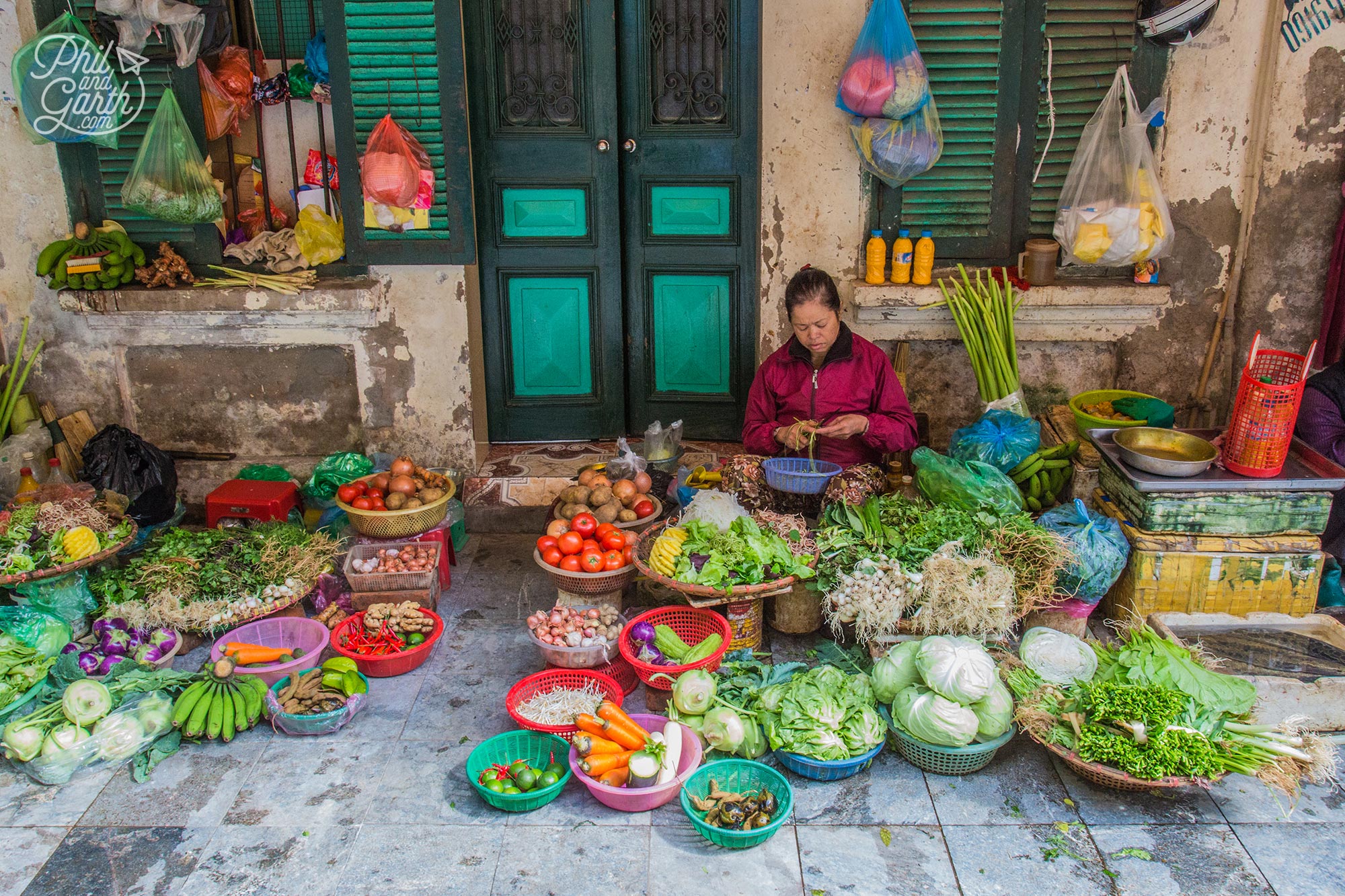
A typical street scene in the Old Quarter of Hanoi
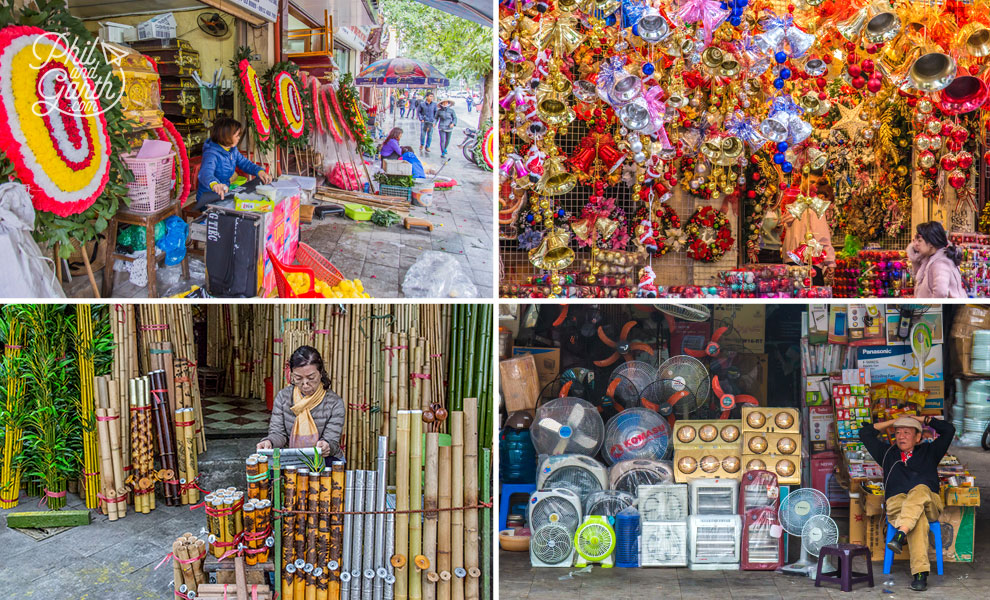
Hanoi’s Old Quarter’s themed shopping streets
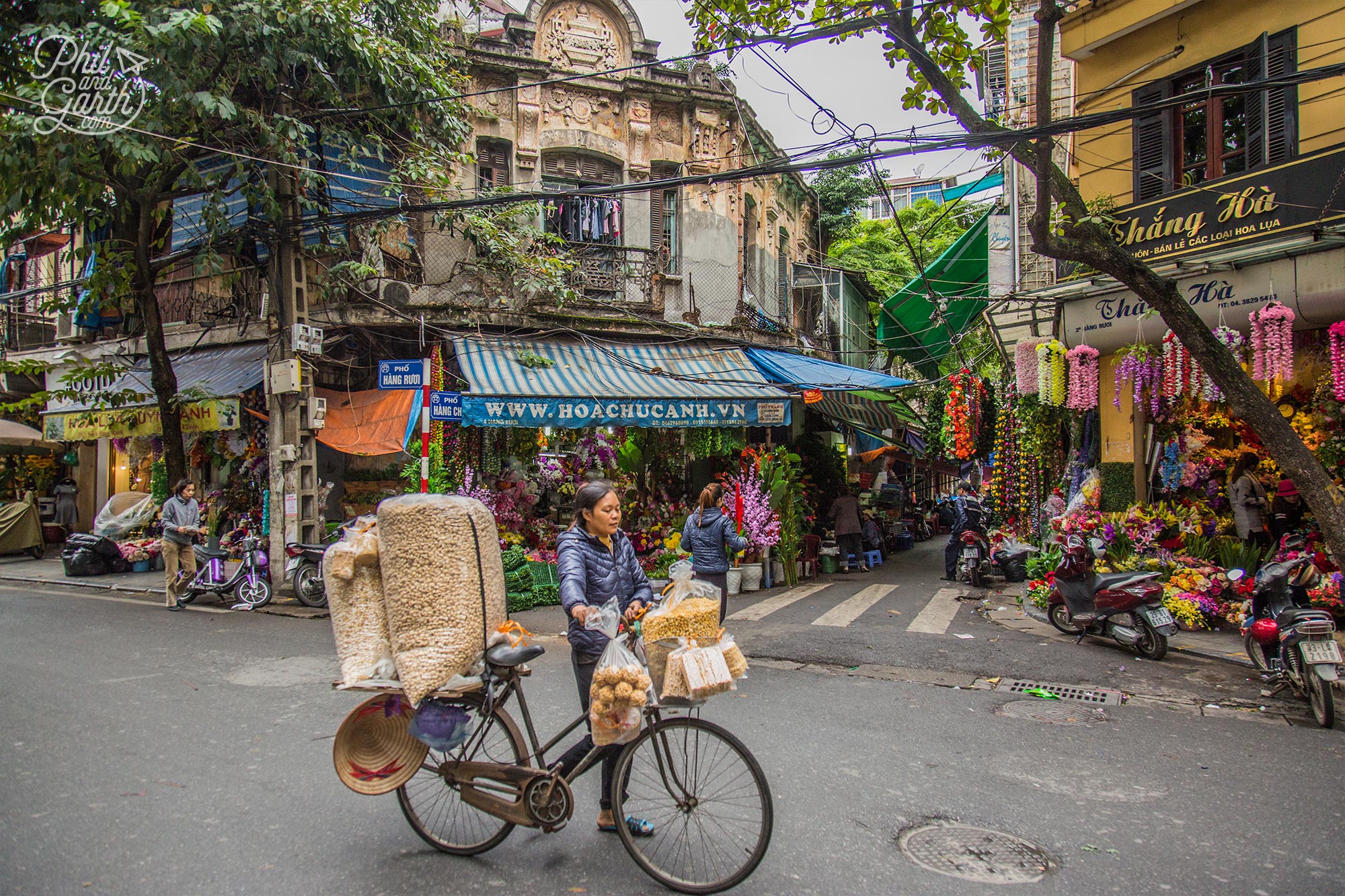
Look up for colonial architecture
The pavements are not for walking on, they are for eating, parking motorbikes or where everything from the shops spill out. Don’t forget to look up occasionally and see what these former merchant houses looked like.
We felt Hanoi was like stepping back in time as we wandered around absorbing the atmosphere, it’s ridiculously easy to get lost, which is half the fun!
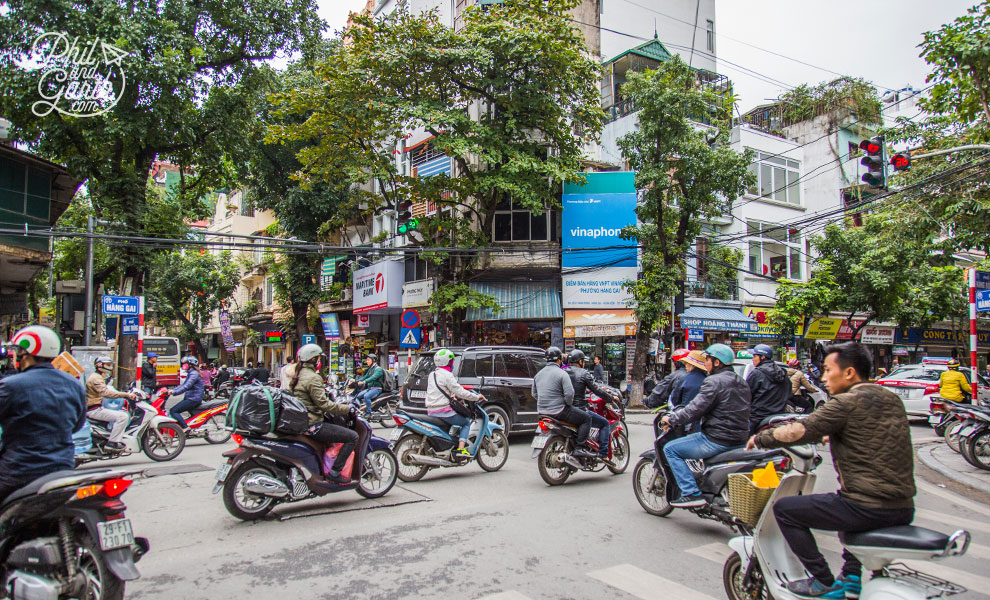
Typical Old Quarter street scene
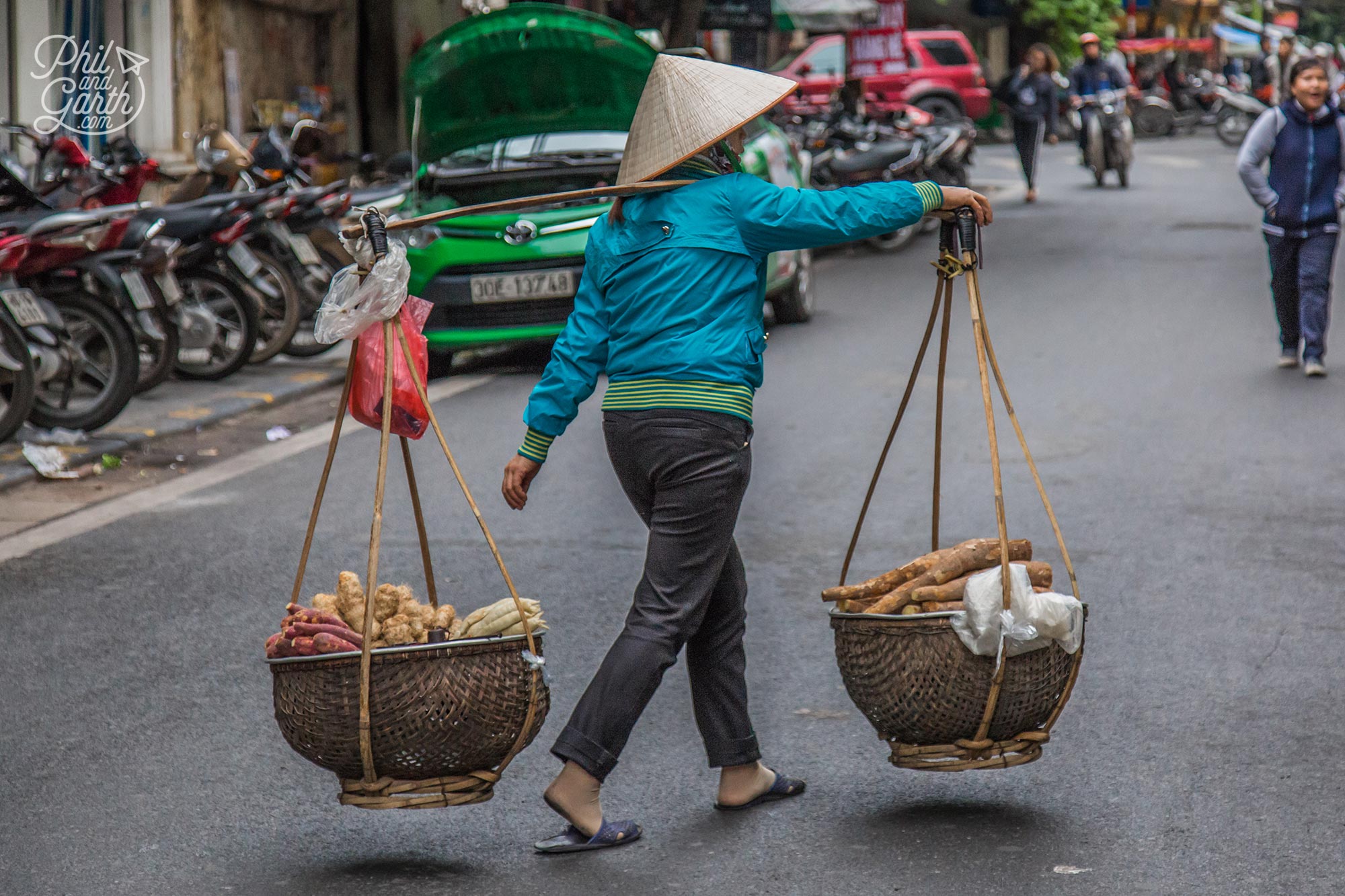
Lady and her yoke selling sweet potato
You’ll see plenty of ladies with their yokes – the wooden bar across their shoulders. Their woven baskets filled with all sorts of produce for sale. Sweet potato, bananas and fried dough seemed pretty popular.
We were particularly fascinated by the ladies that carried pop up cafes, literally. In one basket is a cooker, pots and pans and in the other basket vegetables, chopsticks, bowls and enough plastic seats for 10 people, genius. We were told that people eat out all the time, as they don’t have kitchens or refrigeration at home, space is a premium, this is why street food is so popular.
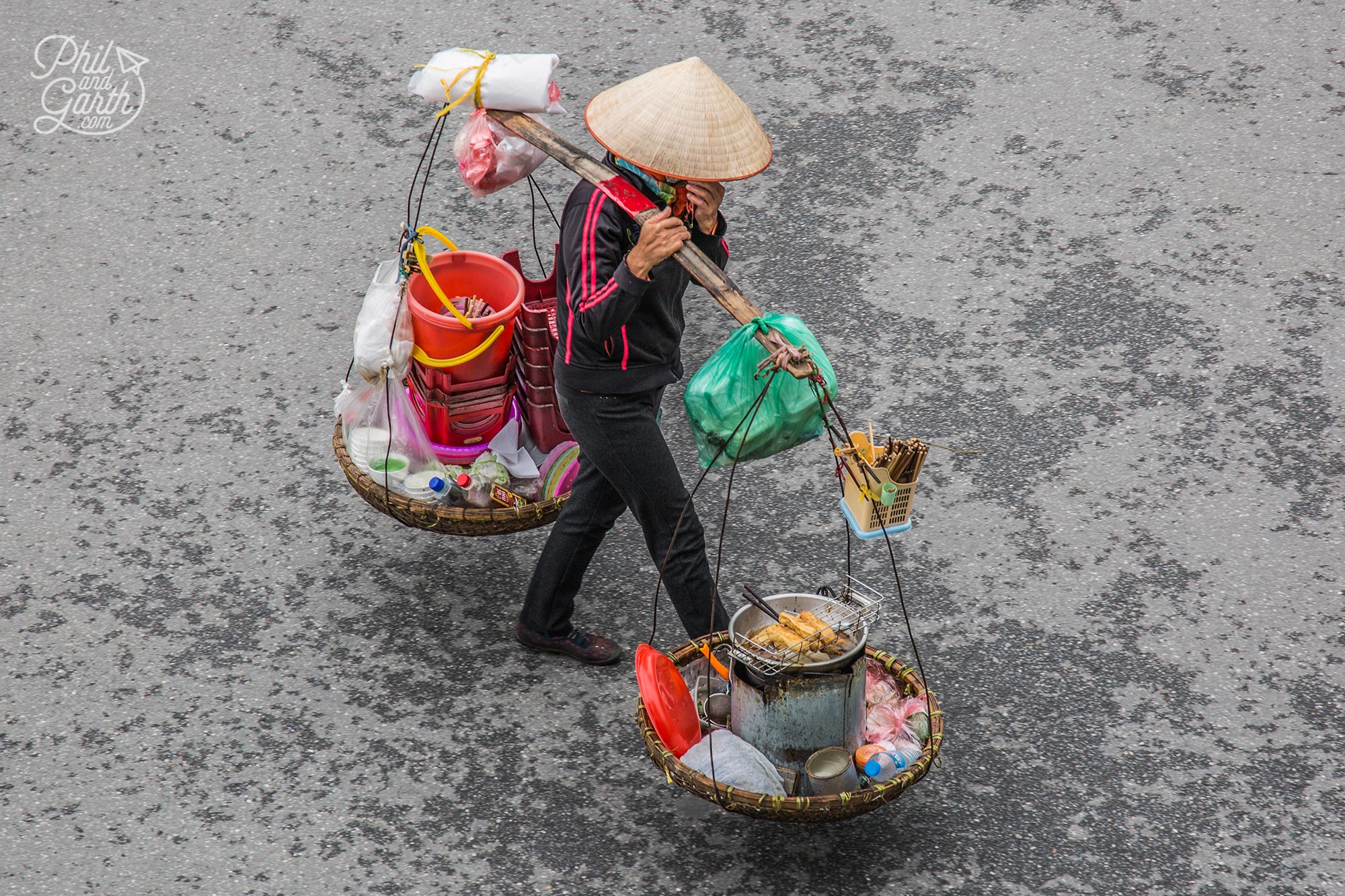
A pop up cafe – complete with chairs, cooker and chop sticks
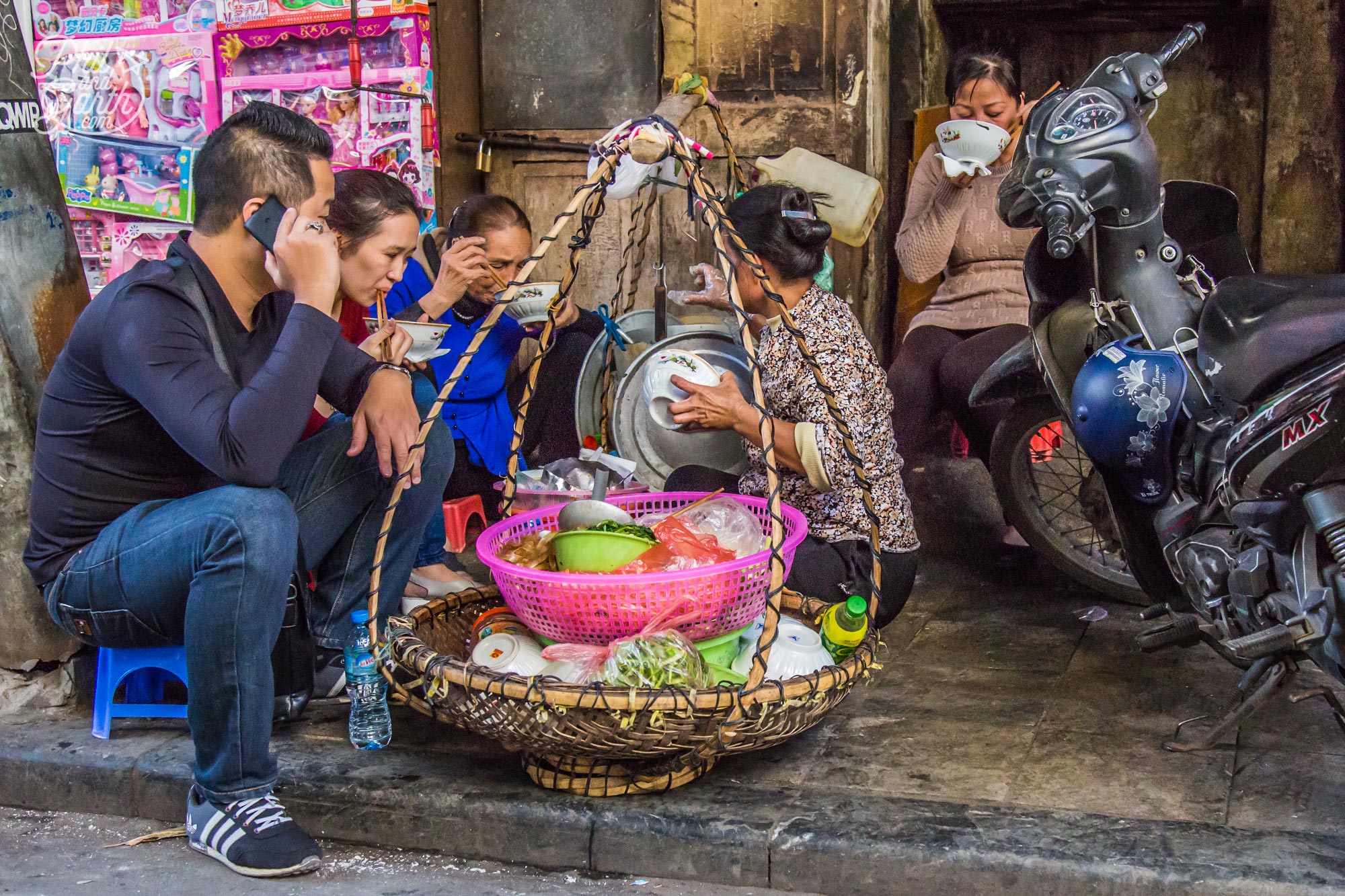
Lady with her pop up cafe
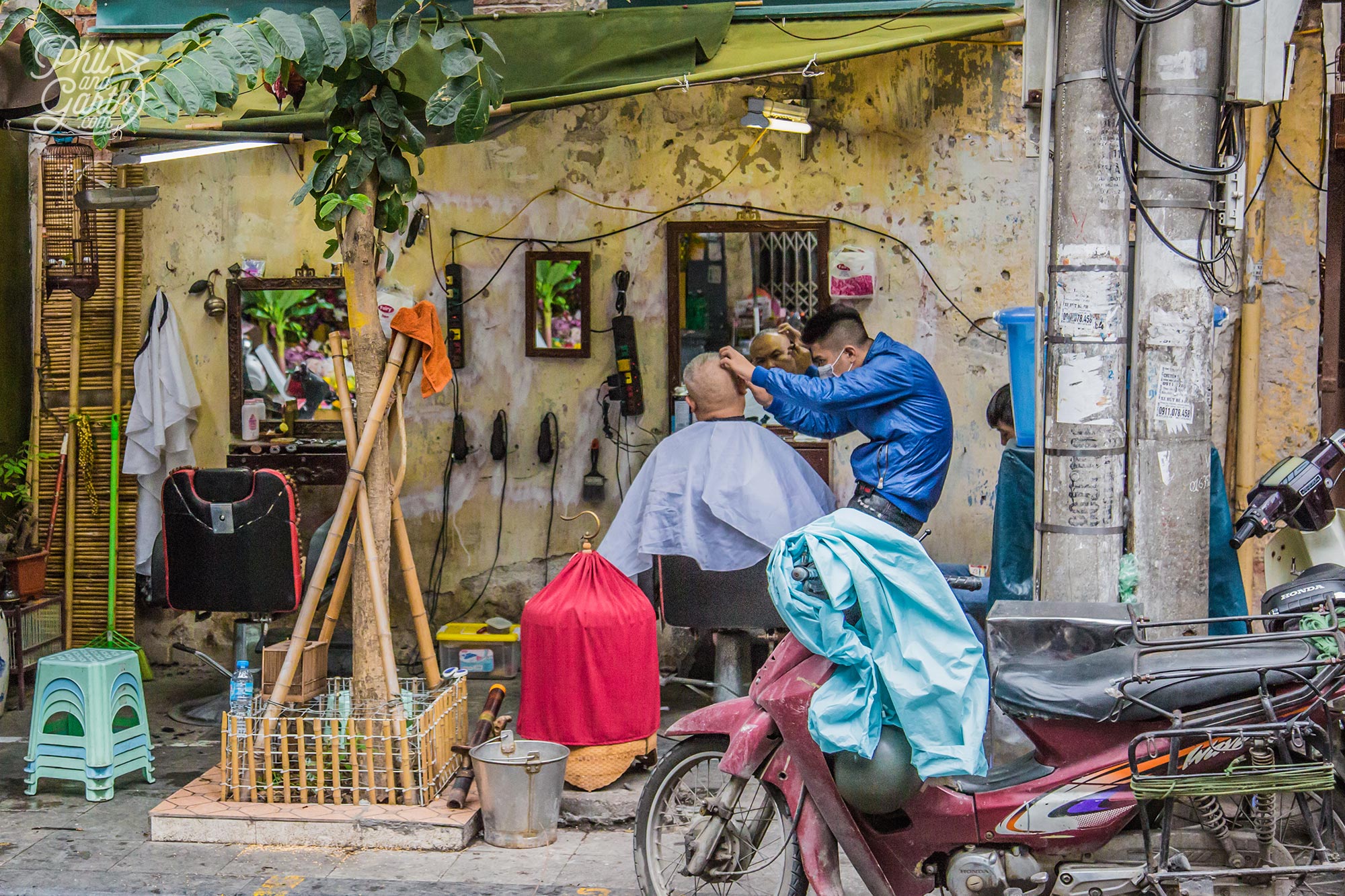
How’s this for an alfresco barber’s shop?
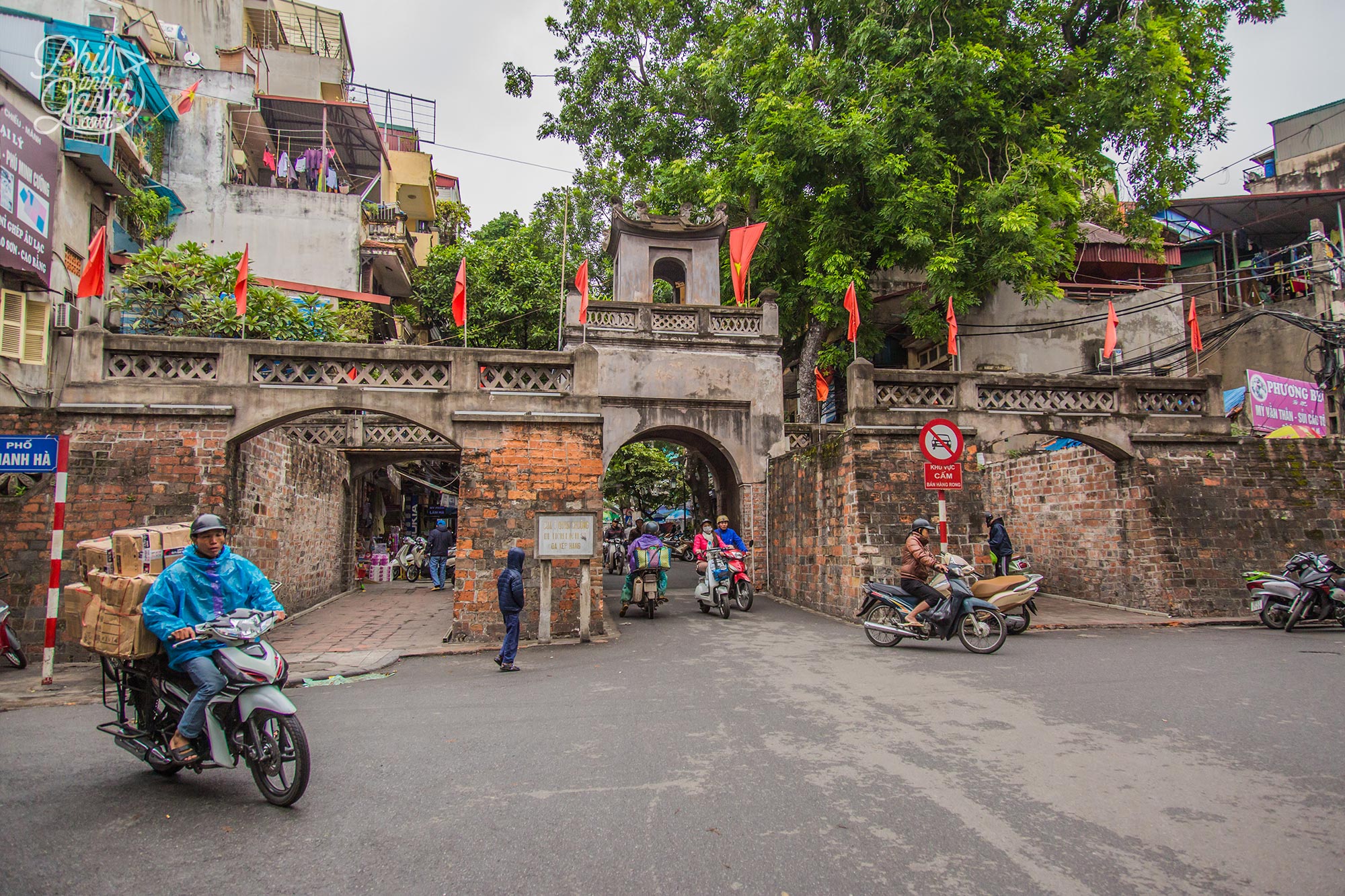
Quan Chuong Gate – one of Hanoi’s old city gates
Hanoi once had 5 gates to enter the city. We found the last remaining one ‘Quan Chuong’ located at the east end of Hang Chieu Street. A remnant of ancient Hanoi’s walled city, the citadel was dismantled in the 1800s.
Bia Hoi Corner – For The World’s Cheapest Beer
You have to order a Bia Hoi, which is a homemade beer, refreshing and tastes just like draught lager. It’s the world’s cheapest beer! about 50 cents for a glass. You’ll find corners like this all over the Old Quarter. The most popular is Bia Hoi Corner at the junction of Ta Hien and Luong Ngoc, a good place to make friends with the backpacker crowd.
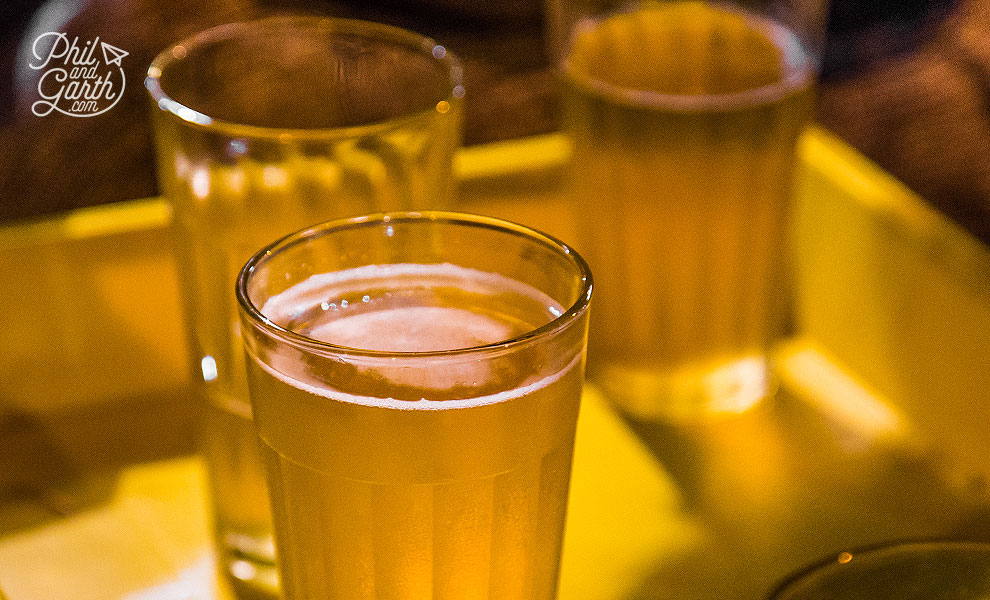
Glasses of Bia Hoi, the world’s cheapest beer
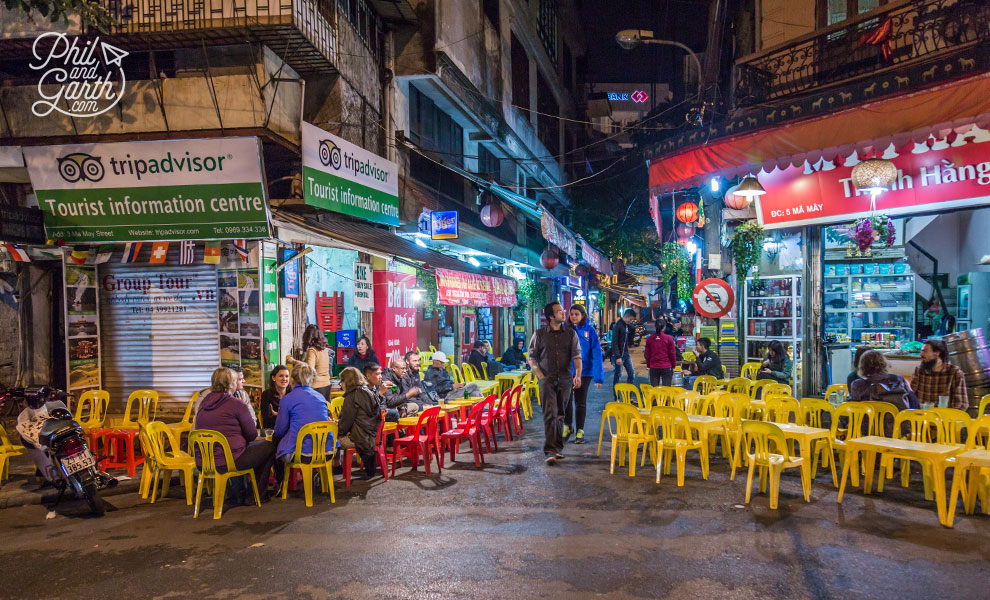
A typical Bia Hoi corner with signature plastic chairs
Watch The Crazy Hanoi Traffic
If you ever thought the White Helmets motor cycle display team looks dangerous, you ain’t seen nothing yet! Imagine them doing their crossovers, throw in a ton of cars and for good measure several people walking across the road, all at the same time! The highlight of the display is when one taxi stops right in the middle of the road to pick up a fare all, accompanied by the sound of honking horns… which mean absolutely nothing!
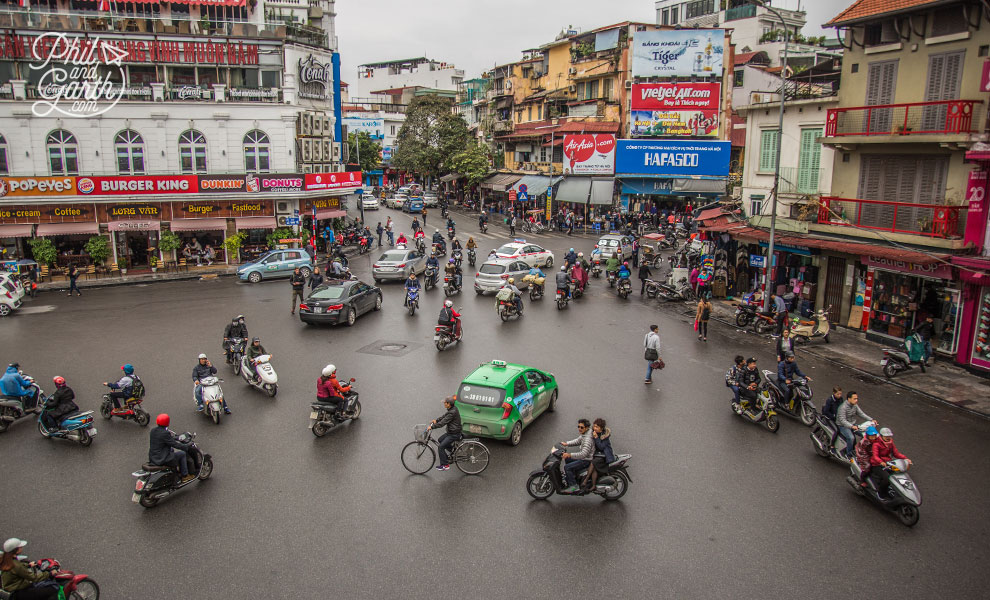
Crazy traffic at the Hoan Kiem Roundabout
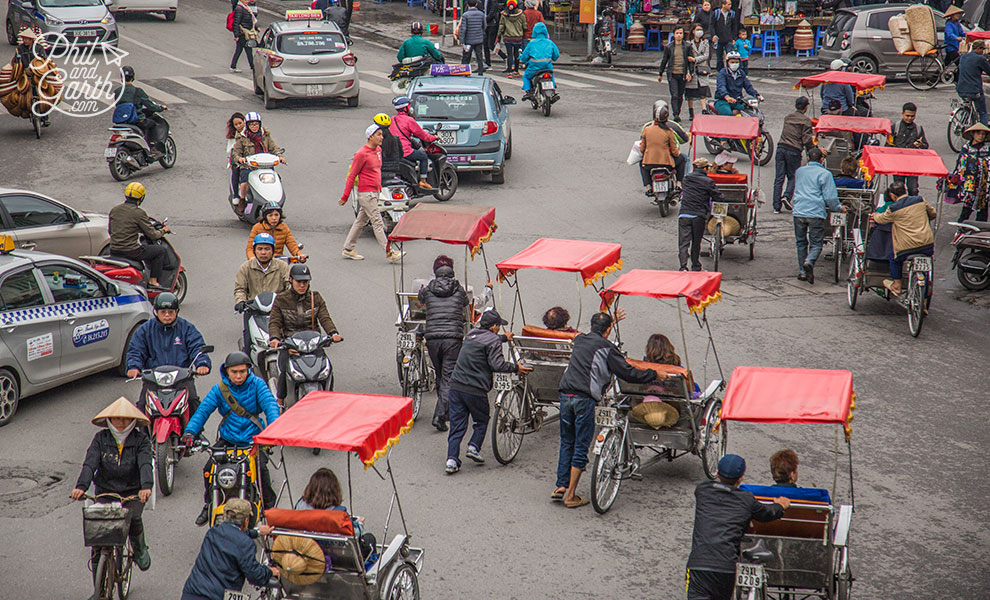
Commit and go!
Our best advice for crossing the road is just commit and go! Walk slow and steady and the traffic will go around you, but don’t cross in front of taxis as they don’t stop! Also the few traffic lights that are around in the city, seem to mean nothing either.
Our vantage point was the second floor of Legends Beer. Order a few beers, but get bottled ones as the glasses looked really dirty and spend an and hour or two like we did just watching the traffic, it’s incredibly addictive! Also a good spot to go if it’s raining. We loved witnessing all the different goods people transport on their bikes, the best we saw was a full size fridge freezer!!
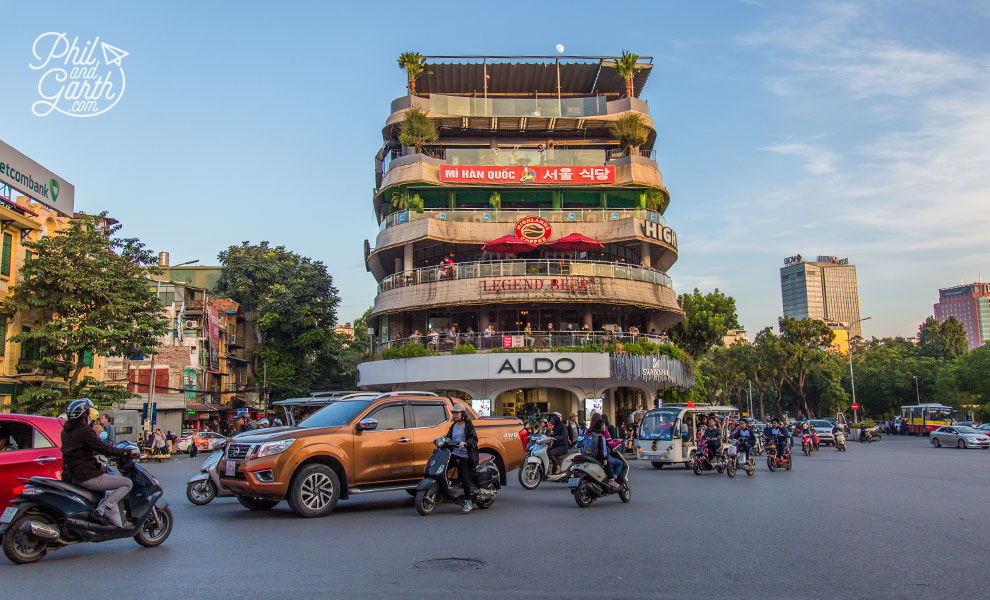
Our vantage point, Legends Beer
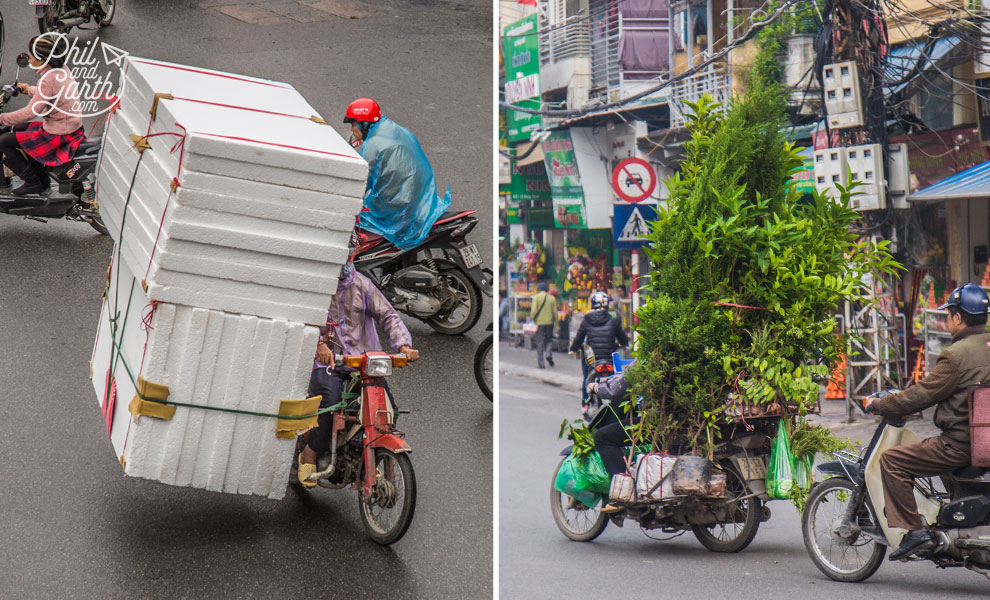
People carry all sorts on their bikes
Train Street
Unbelievably there’s a train track running through a couple of small residential streets, right by our hotel so we had to go investigate. Trains pass scarily close to the entrances of houses, just a couple of steps in some places. So beware and get your timings right as the train passes through twice a day and it passes through at speed, mind the gap!
To find it, it’s located between Lê Duẩn and Khâm Thiên streets. It is authentic glimpse into local life, where people make use of what little space they have. This wasn’t the first train we’ve seen that runs through a residential area, we went to another one in Bangkok.
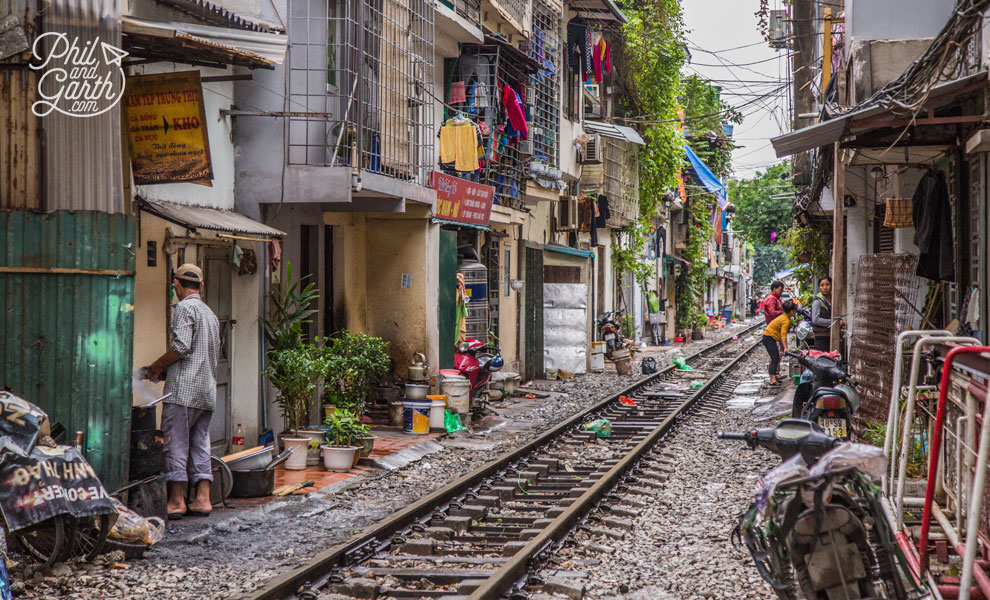
Hanoi’s train street
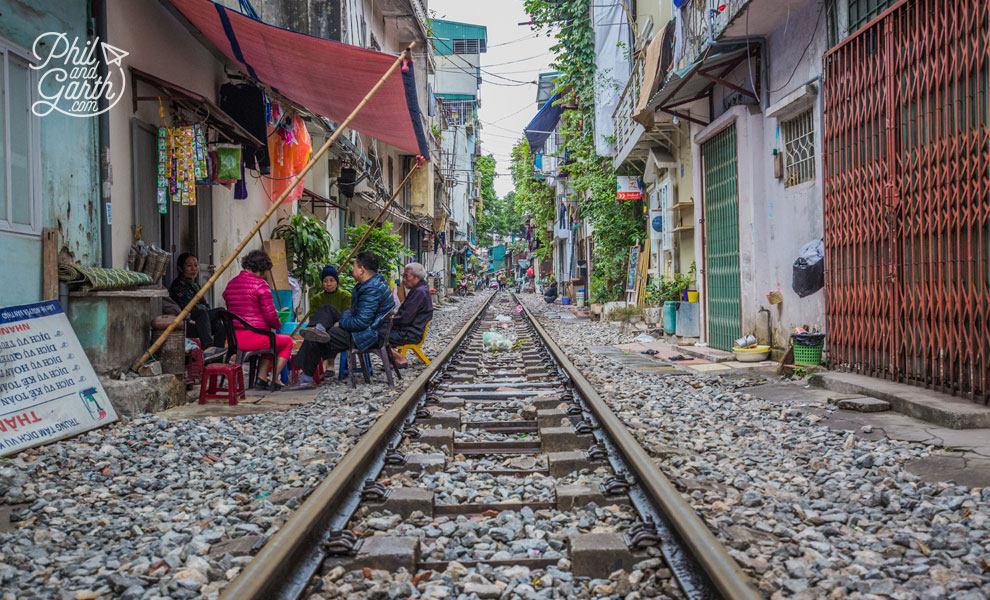
There are even a small shops on train street
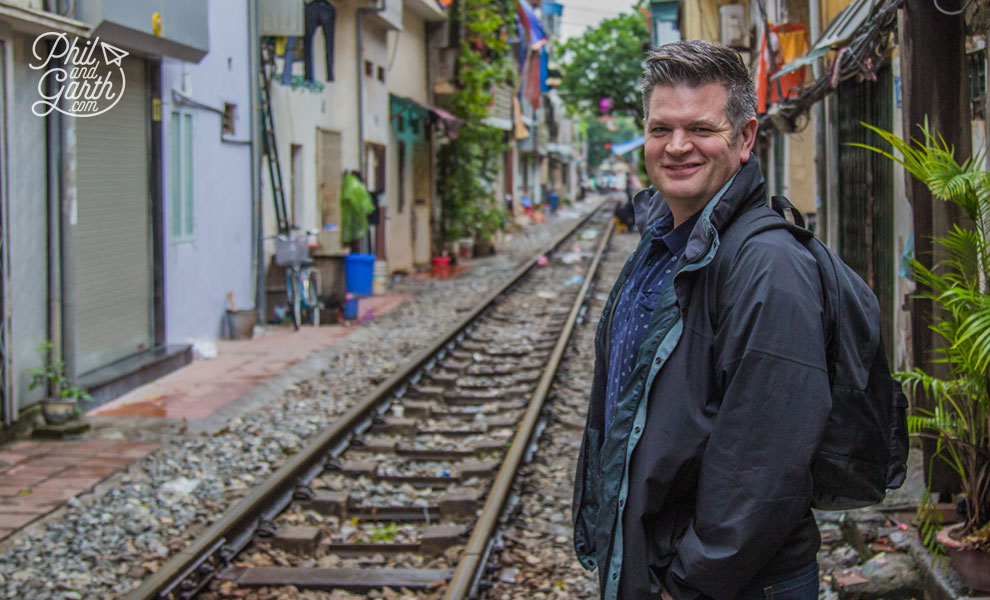
Phil on Hanoi’s train street
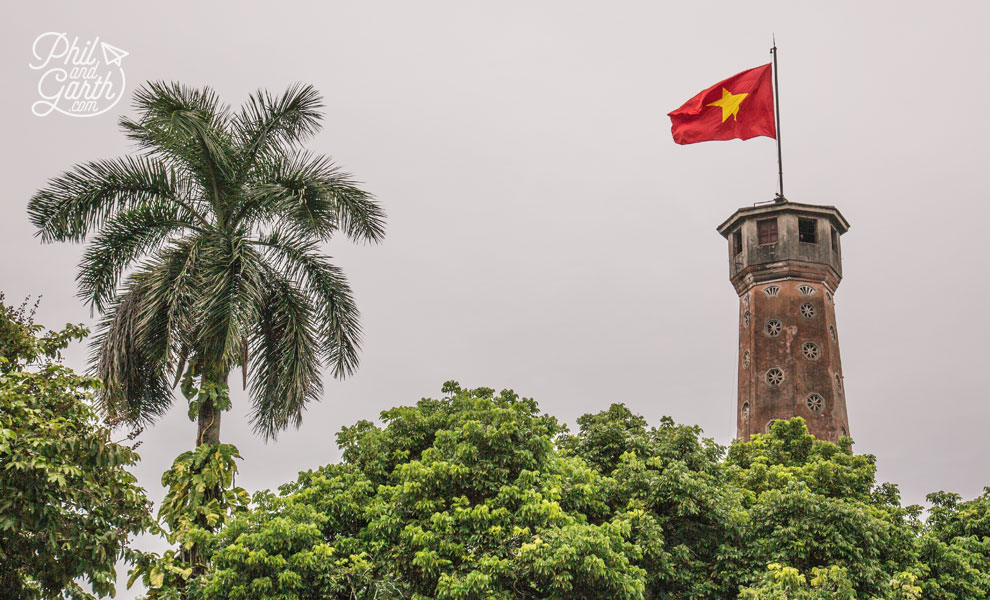
The Flag Tower
A short walk from train street was the Unesco site of the Imperial Citadel of Thang Long, we didn’t go in and just look a photo of The Hanoi Flag Tower, the most visible part where a huge flag flies, it’s a landmark of the city.
Hoan Kiem Lake
Hanoi is known as “The city of lakes” about 20 lakes in total, the most popular one is ‘Lake of the Restored Sword’. It was the perfect place for a walk to escape the noise and hustle of the Old Quarter.
Hoan Kiem is named after a legend says that a magical sword was sent from heaven to Vietnamese Emporer Ly Thai who used it to beat the Chinese out of Vietnam, he then returned the sword to a turtle god in the lake. A small stone pagoda called Thap Rua (Turtle Tower) on Jade Island in the middle of the lake commemorates this mythical moment.
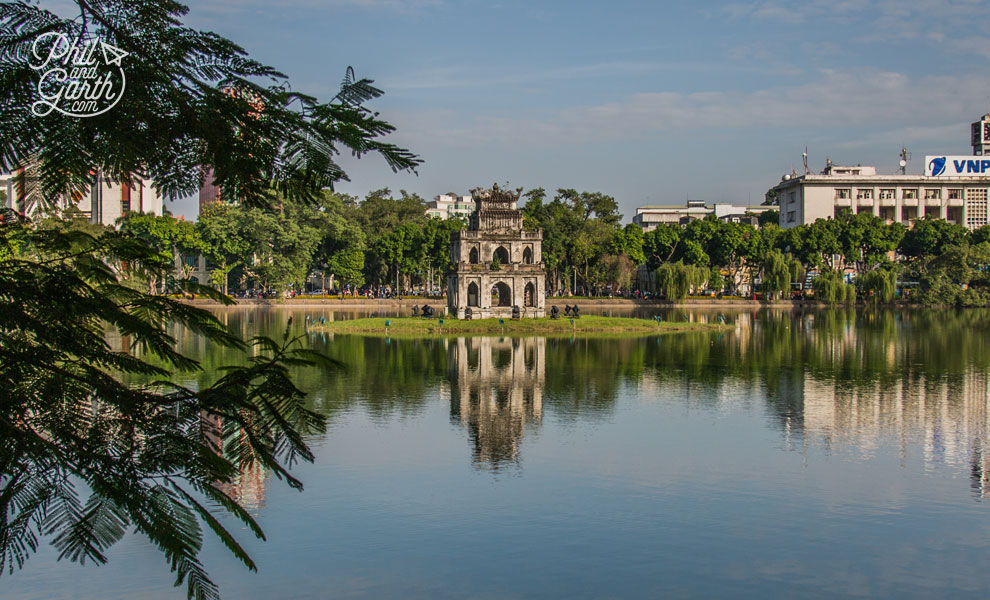
The Turtle Tower in Hoan Kiem Lake
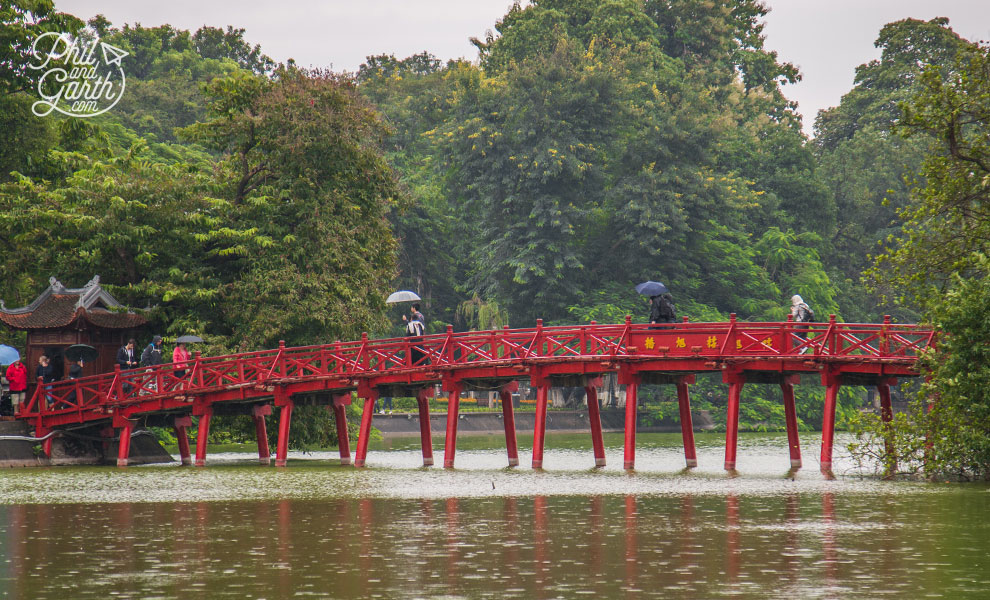
The picturesque red Huc Bridge
At the other end of the Hoan Kiem was Hanoi’s iconic bright red bridge, The Huc Bridge. It’s really picturesque and a piece of classic Vietnamese design connecting to a small island with Ngoc Son Temple.
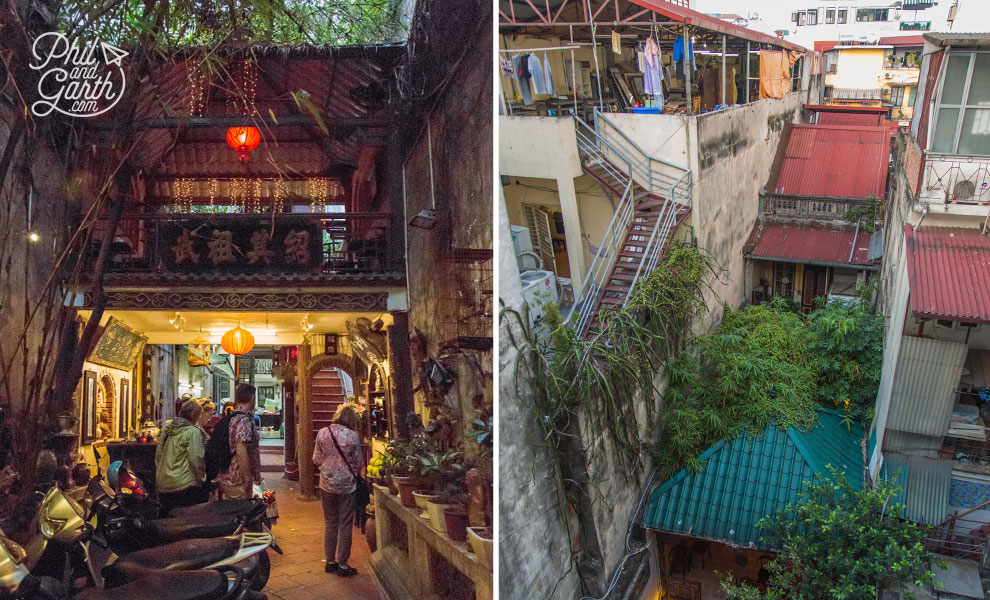
Cafe Pho Co a hidden gem for lake views
For a nice view of Hoan Kiem try the high vantage point at Cafe Pho Co. It’s quite hard to find, as you have to walk though a fabric and souvenir shop to the back until you enter a courtyard. There’s no table service so order at the counter downstairs and then grab a seat on their roof top terrace.
It’s very atmospheric, like a little temple. We liked it at night, when the lake and trees are lit up with kitsch coloured lights, very typical of South East Asia, remember more is more! We were also told at 6am Hanoi residents practise traditional tai chi along the lake.
Ho Chi Minh Mausoleum
Ba Dinh Square is the final resting place of Ho Chi Minh where he lies in state in an imposing Mausoleum, modelled on Lenin’s Mausoleum in Moscow. You can visit his embalmed body in a glass case, but it was closed when we were there in November as he was undergoing his annual ‘maintenance’.
Even after death, he is still a national treasure and worshipped by the Vietnamese, who call him “Uncle Ho”. To preserve his body Uncle Ho used to go to Russia for ‘maintenance ‘ But in 1977 the Russian doctors gave the secrets to the Vietnamese so now he doesn’t need to travel. Our guide told us he stays in the mausoleum and the coffin goes down beneath the floor where the embalming happens.
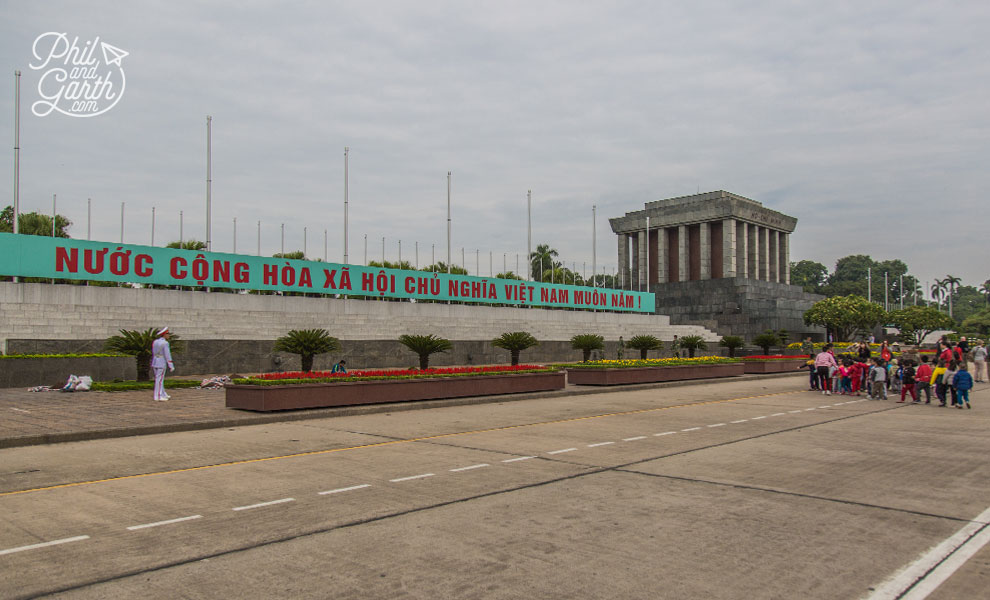
The Ho Chi Minh Mausoleum, the text reads “Socialist Republic of Vietnam forever!”
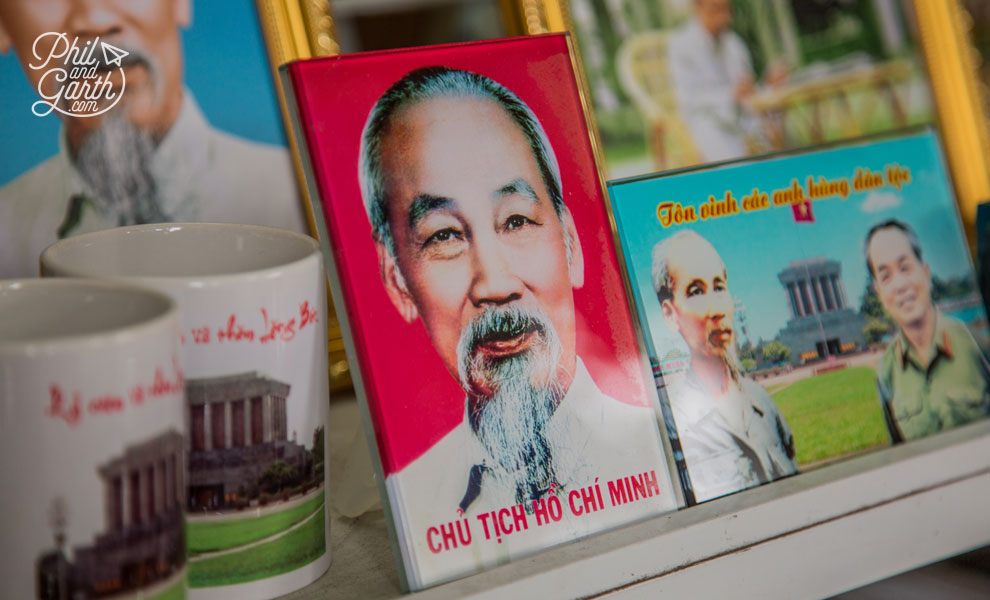
Ho Chi Minh souvenirs
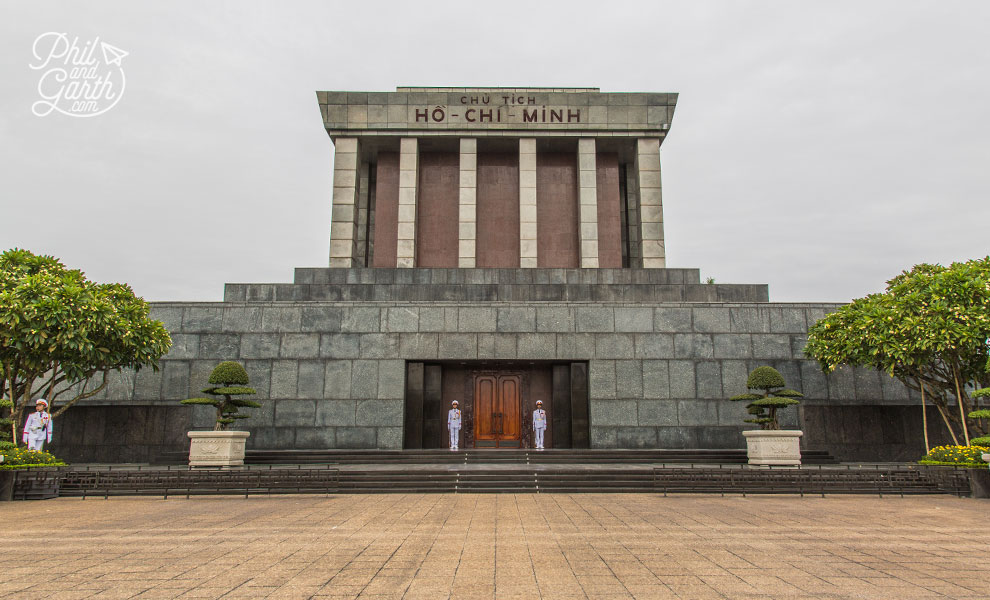
The imposing Ho Chi Minh Mausoleum
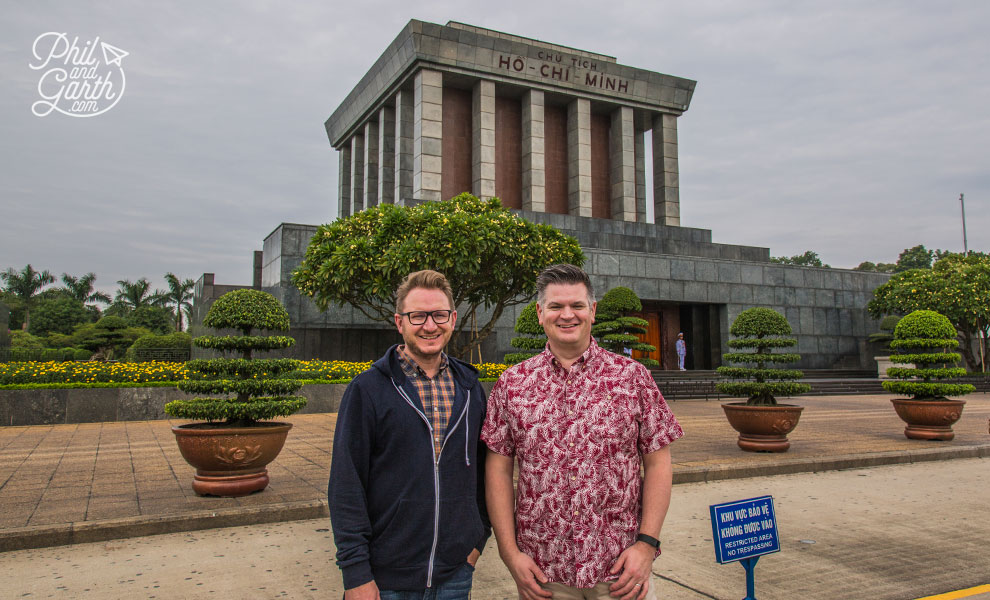
Garth and Phil at the Hoi Chi Minh Mausoleum
“All men are created equal” the words of Ho Chi Minh’s Declaration of Independence speech which he read in 1945 at the exact spot where the Mausoleum was built.
Ba Dinh Square is based on Red Square, like it’s Russian counterpart Hanoi used to have huge military parades. Today parades are less common as the money is used to help the poor. We stayed to witness the changing of the guard. Just make sure you don’t step over the yellow line watching, as guards will shout or blow whistles at you.
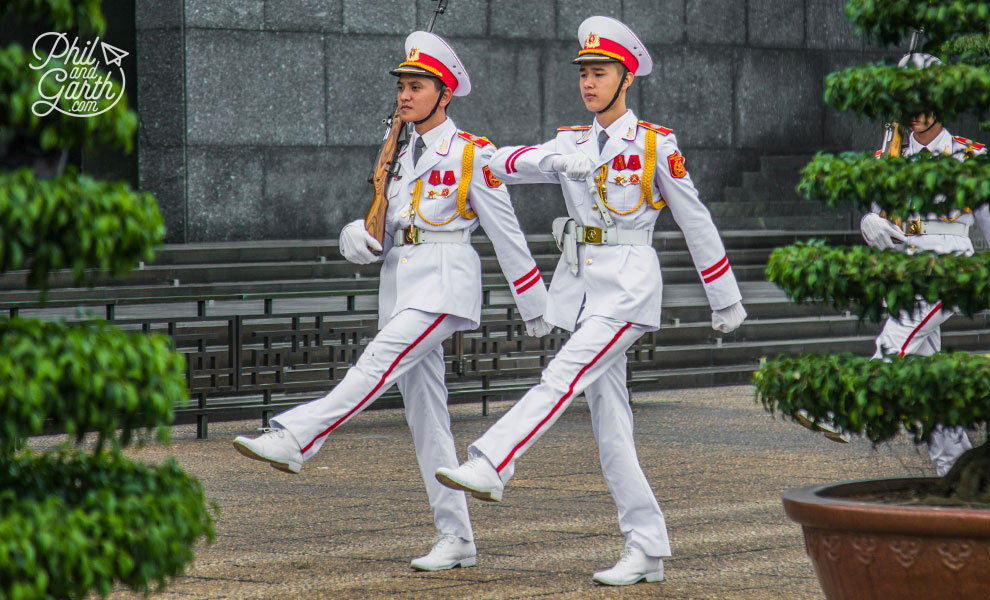
Changing of the guards
Presidential Palace
A very short walk from the Mausoleum is The Ho Chi Minh complex, which houses the Presidential Palace. It’s bright yellow, you can’t miss it! Built in 1906, it’s was the former home of the General Governor of French Indochina until 1954 when Vietnam gained independence. The Palace became Uncle Ho’s new home, but he didn’t like it, so he built a more modest home on in the palace grounds.
As you walk around the fish pond, there are dozens of tree roots that unusually grow up, they’re from Cypress or “Buddha trees”
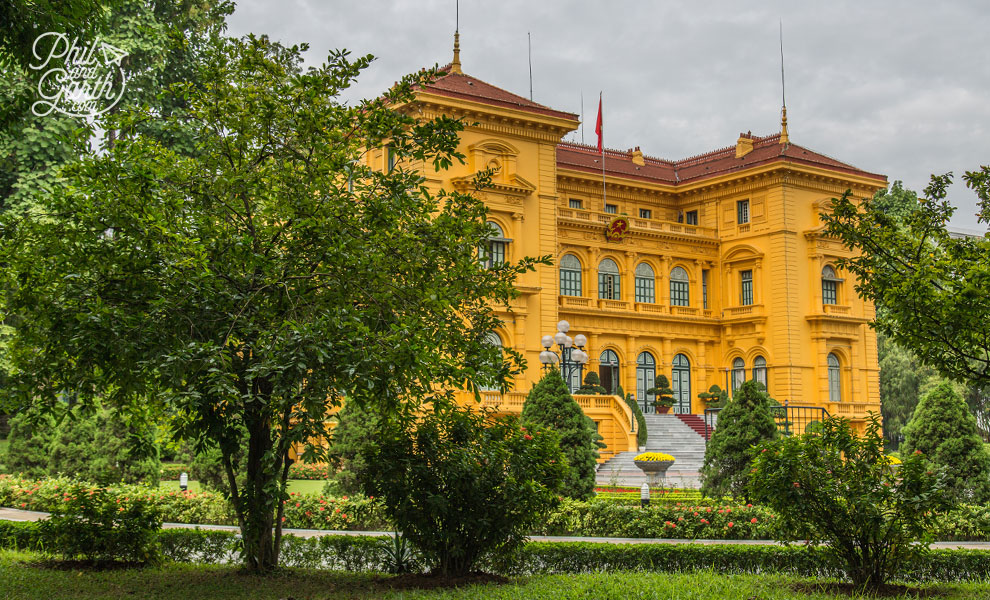
The Presidential Palace of the former General Governor of French Indochina
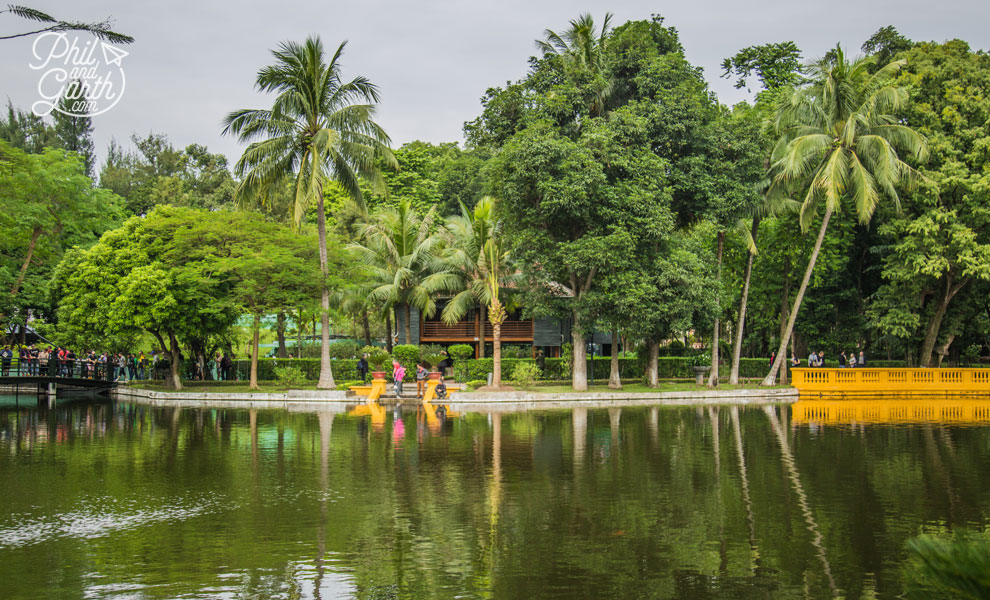
Uncle Ho’s stilt house on the bank of the fish pond.
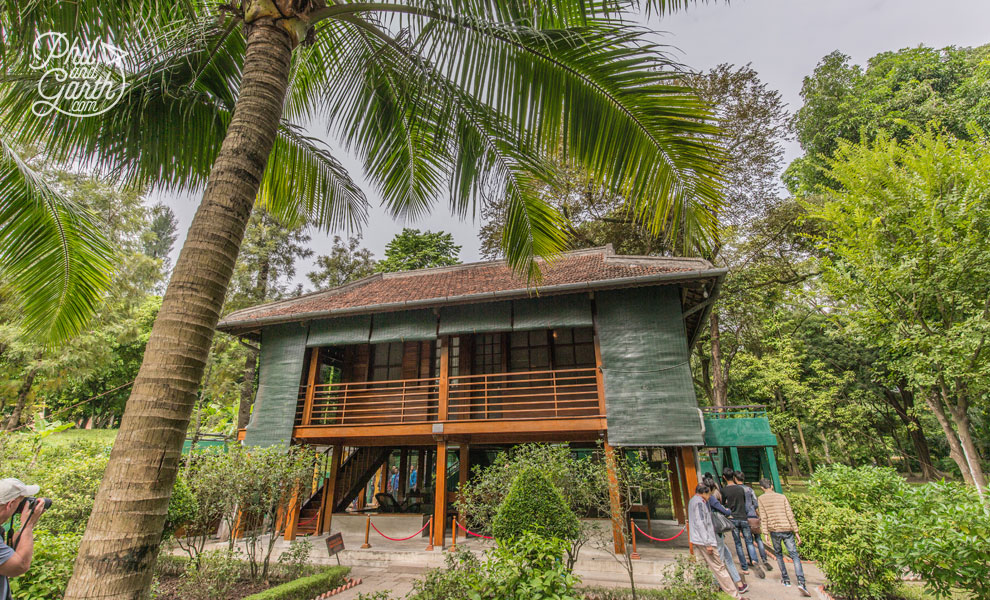
Uncle Ho’s modest stilt house
In the tranquil grounds of the palace was Uncle Ho’s Stilt House, this is what he built as Uncle Ho preferred to live in simple and modest surroundings instead of the luxury of the Palace. The houses comprises a study, a bedroom and Uncle Ho’s books and simple belongings are exactly where he left them, including the telephones he would have used during the war. Clocks are kept ticking to remind people of his presence.
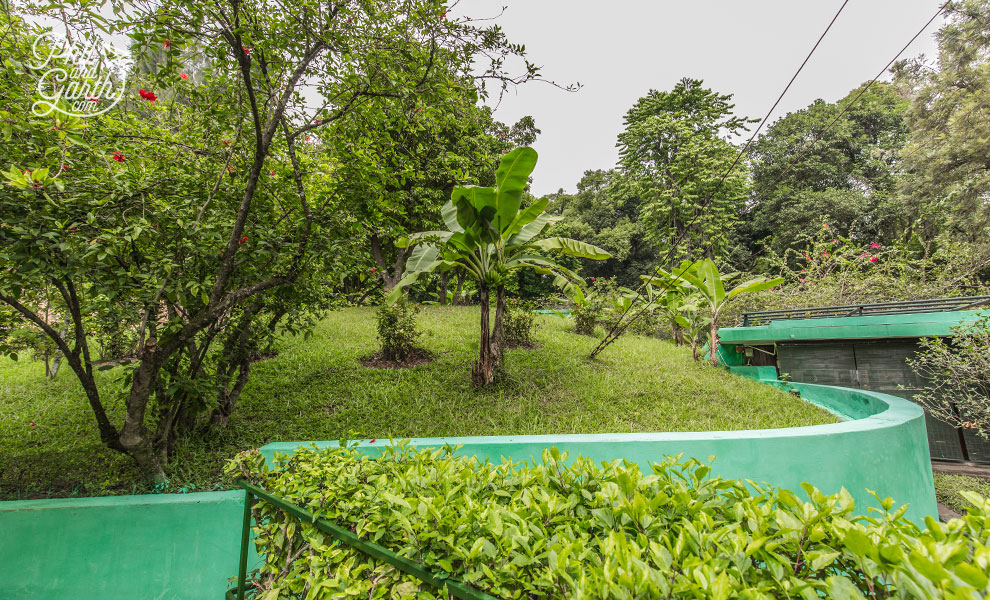
Uncle Ho’s hidden air raid shelter
Look out for the hidden air raid bunker as you exit, it’s very well concealed. This is where Uncle Ho sheltered during the war.
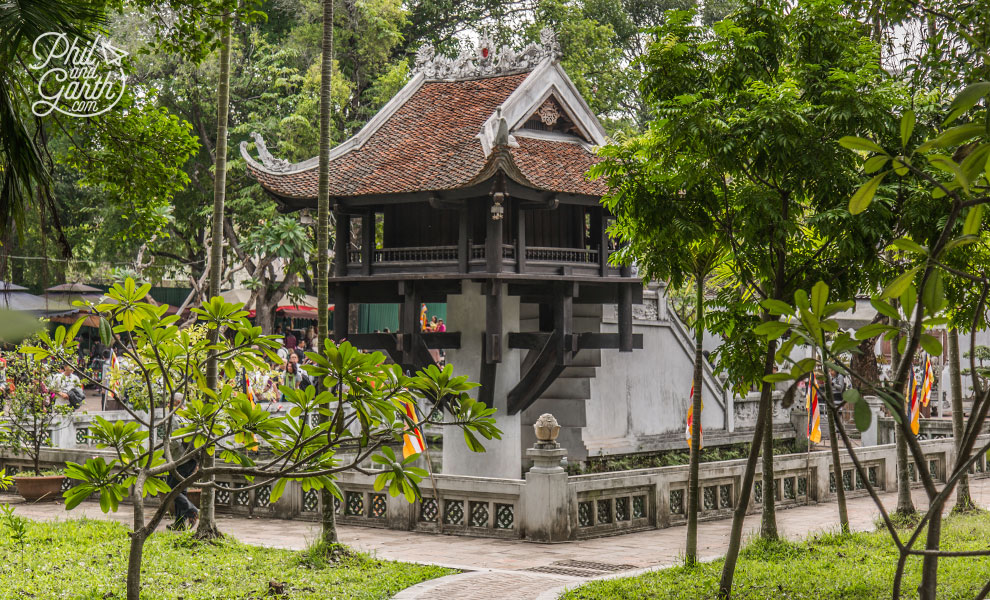
One Pillar Pagoda
Resembling a lotus flower is the One Pillar Pagoda. It houses a small Buddhist temple, dating back to the 11th century.
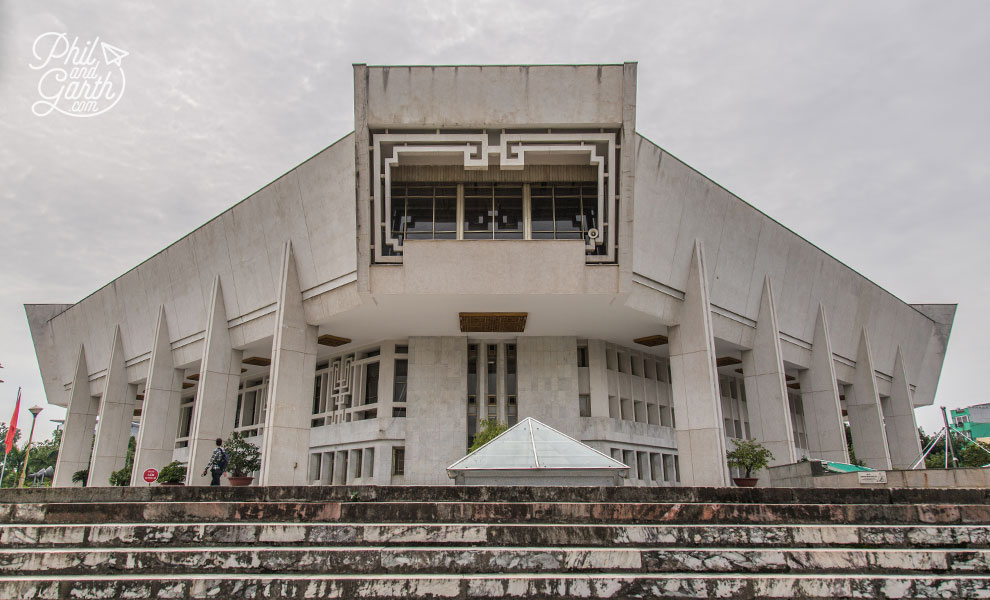
Communist style architecture of the Ho Chi Minh Museum
Also in the grounds we checked out the House No.54 where Uncle Ho performed his daily work and the soviet era cars used to serve the President.
The Temple of Literature
Another sight you should visit is the Temple of Literature. Built in the 11th century, it’s dedicated to the Chinese philosopher Confucius. It’s Vietnam’s first university, established in 1076. Originally royalty and the elite were excepted as students, but eventually everyone was accepted.
The temple is made up of 5 courtyards each symbolising a journey in knowledge. 3 paths run the whole length. Royalty would have used the middle path.
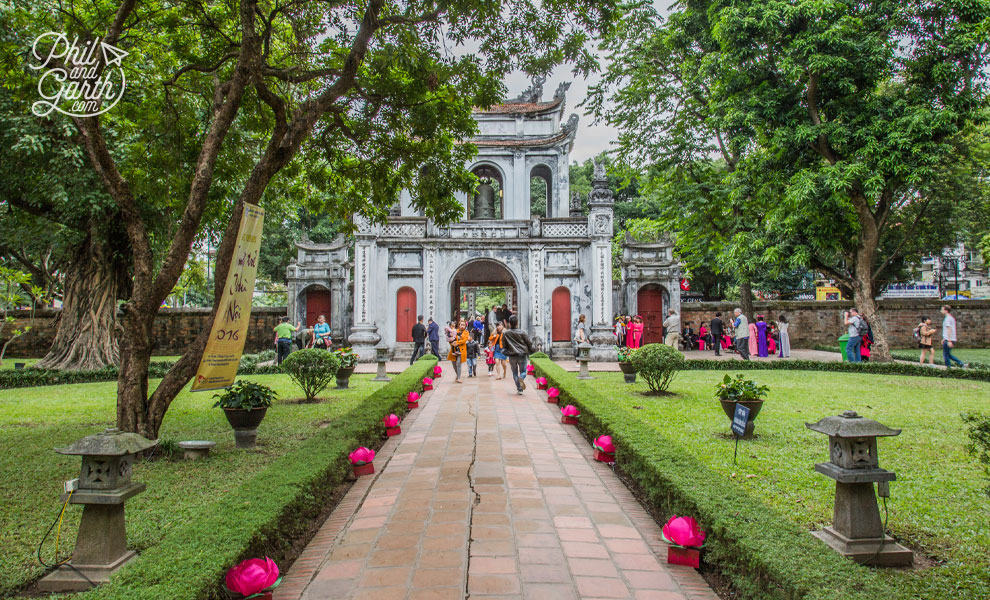
The Great Portico, entrance to the Temple of Literature
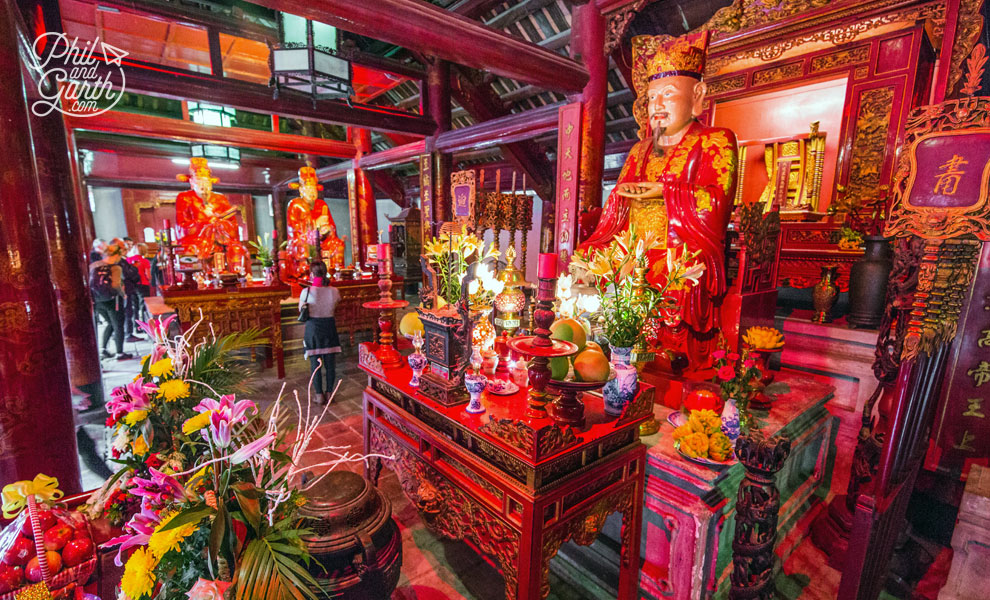
Great House of Ceremonies
At the innermost courtyard we found the Great House of Ceremonies dedicated to Confucius. His bearded statue sits next to four of his disciples. Students would come here and still do to pray before taking their exams. At the alter people offer money, food, we even saw crisp packets!
The temple grounds were packed with graduation students having their pre-graduation photos taken. They better make sure they pass!
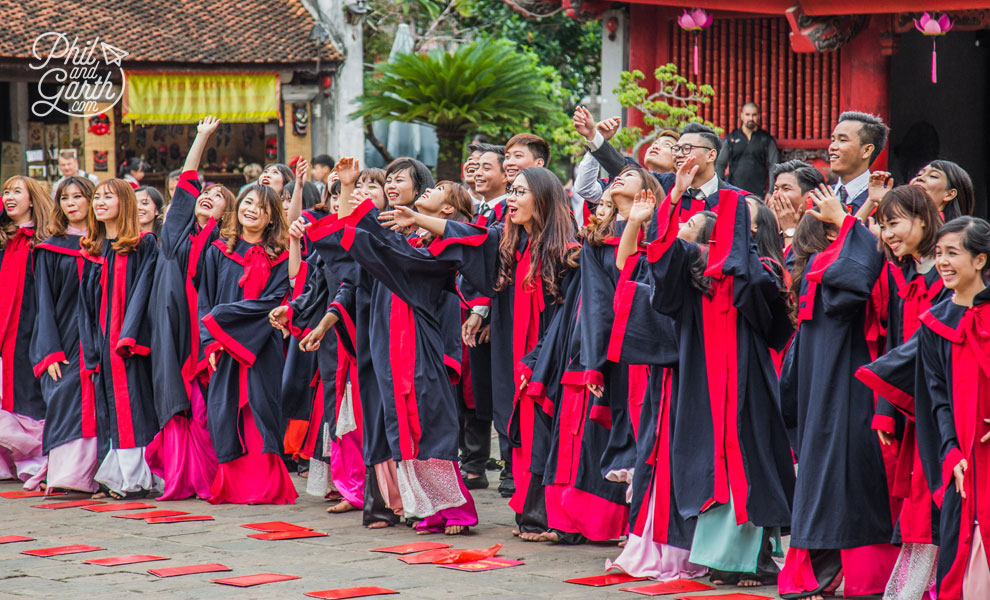
Pre-graduation photos
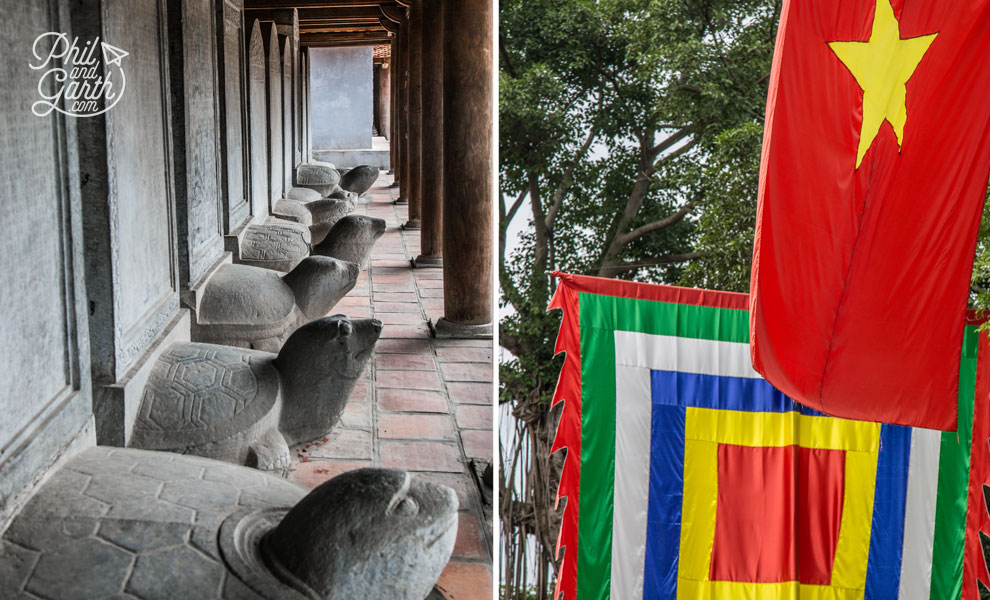
Names of successful students were carved on the stone ‘stele’ above the turtles
Under a pavilion are stone turtles with the names of students who passed their exams. Today they are rubbed by students in need of good luck. Turtles are considered sacred by the Vietnamese.
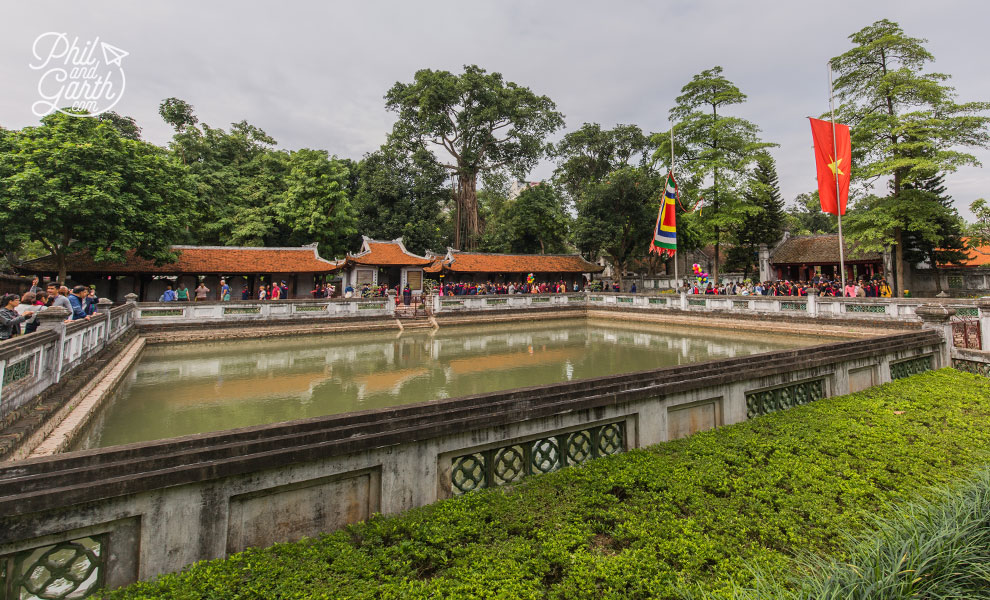
The ‘Well of Heavenly Clarity’ pond
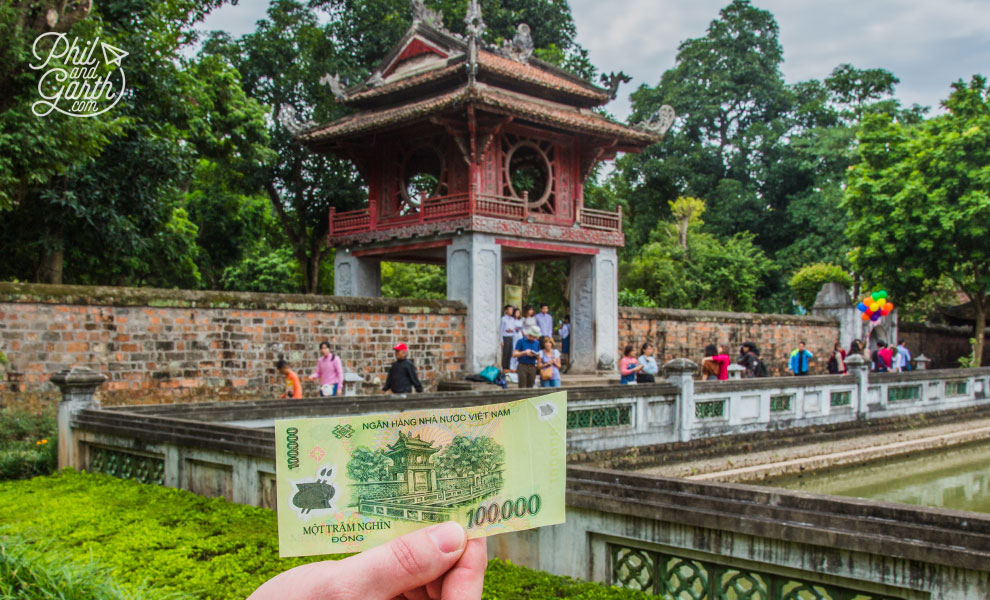
The Temple of Literature as featured on the 100,000 Dong banknote
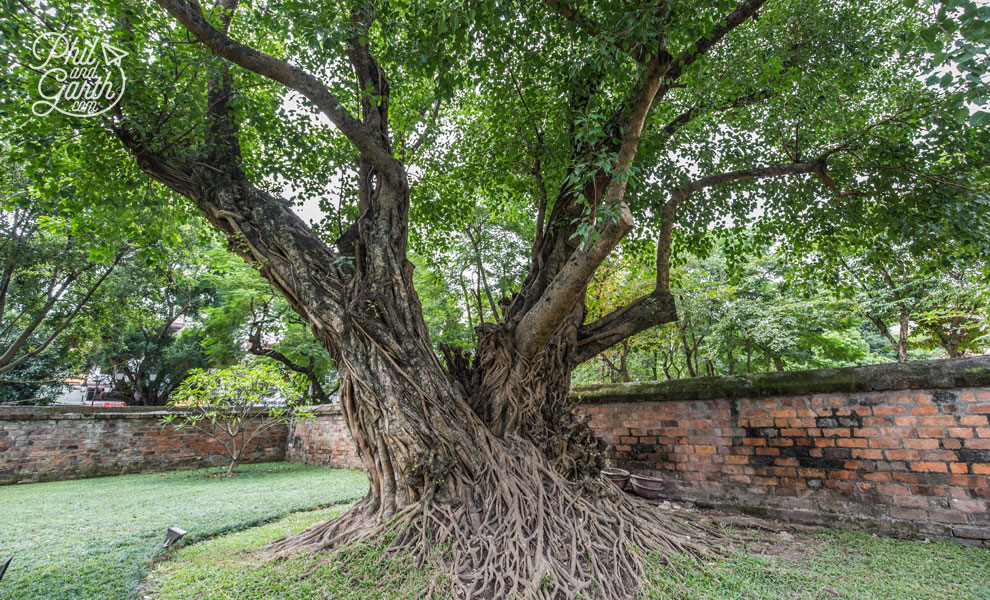
1,000 year old Banyan Tree
We enjoyed wandering the formal gardens and the manicured grounds, they are beautifully kept and full of ancient trees and lily filled ponds. The most famous tree in the first courtyard was a huge Banyan tree over 1,000 years old.
West Lake & Tran Quoc Pagoda
A short taxi ride to the north of the city is Hanoi’s West Lake this is where United States Senator John McCain was shot down and nearly drowned. Opposite is Hanoi’s oldest Buddhist temple, Tran Quoc which dates back to the 6th century. Outside hawkers sell small fish and baby turtles for people to release into the lake for good luck and prosperity. Garth felt really sorry for them and wanted to buy and release them all, but apparently the vendors just scoop them up and resell them.
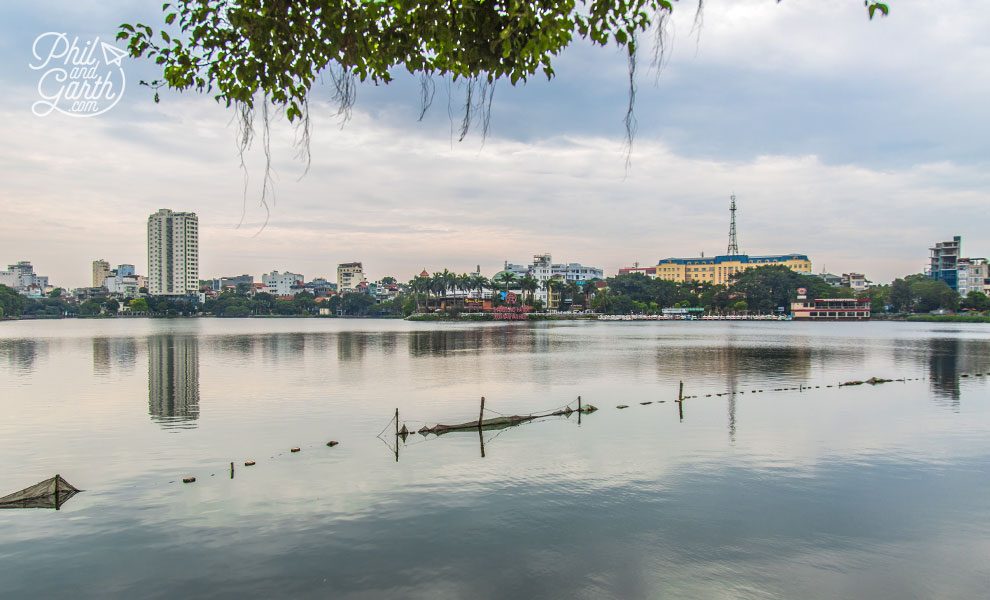
Hanoi’s West Lake
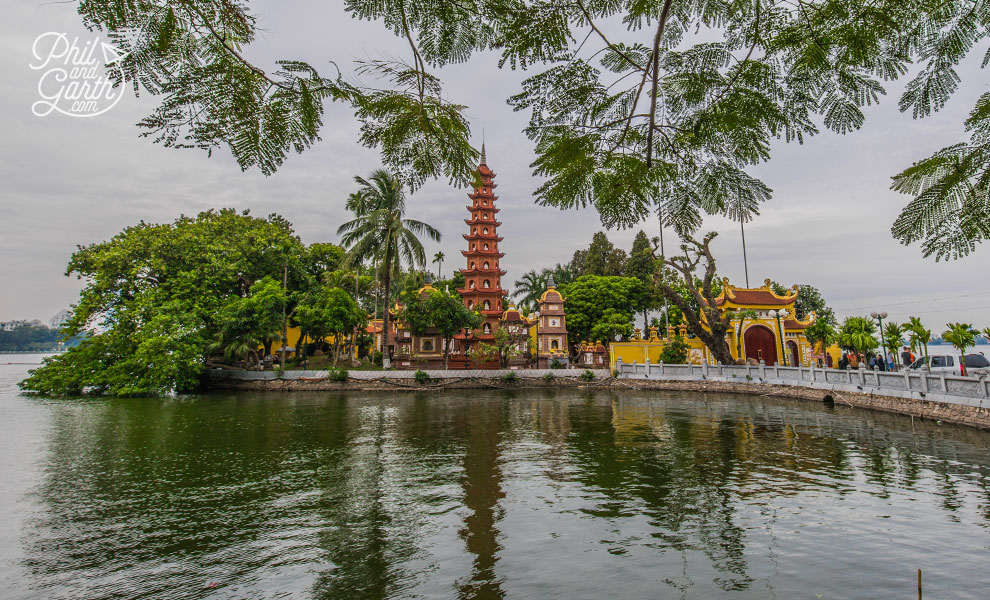
The Tran Quoc Pagoda reflected in the water
The temple is in an attractive setting on a small island called the ‘Golden Fish Island’ which walk to via a small causeway. The pagoda is ornate and stunning close up. Phil loved the amazing bonsai trees at its base next to the monks tombs.
Inside the temple many people were praying to the deities and making offerings of fruit and even chocolate. Outside the air was filled with incense and smoke from the joss sticks. There was a fire pit to burn ‘ghost money’, fake money, is another popular offering. This temple was quiet as it’s very much an active and a working temple.
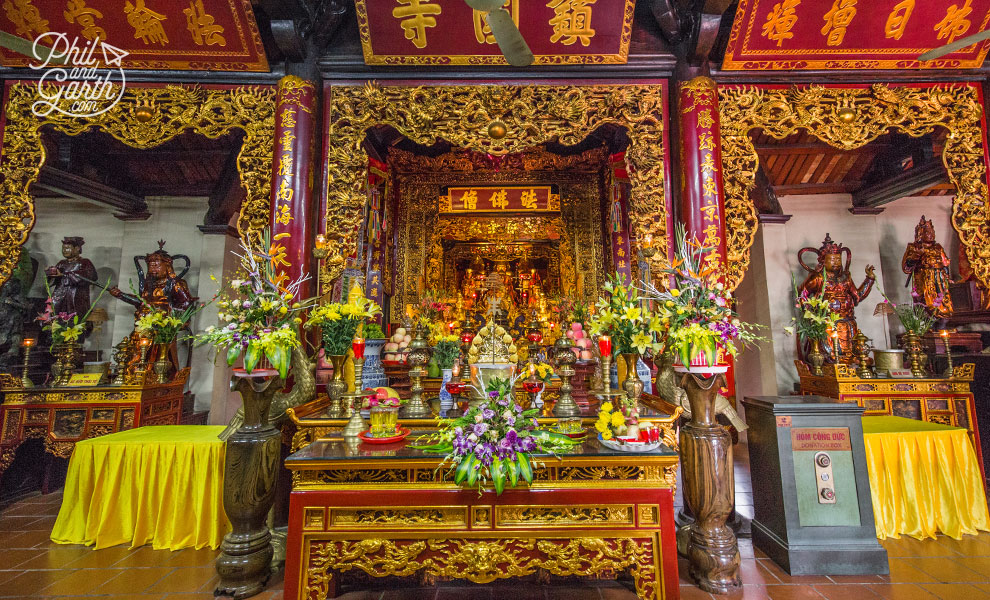
Inside the Tran Quoc temple

50+ year old Bodhi tree
At the rear of the temple was a 50+ year old Bodhi tree. Grown from a cutting of the original tree in India under which the Buddha achieved enlightenment.
Quan Thanh Temple
A 10 minute walk from Tran Quoc was another ancient temple – Quan Thanh. This is the first Taoist temple we’ve ever been to. With a stunning entrance gate it’s situated right next to a busy road, but very peaceful and quiet inside. It’s one of 4 sacred temples from the founding days of Hanoi. Legend says a turtle told the King to build 4 temples in 4 directions to protect city.
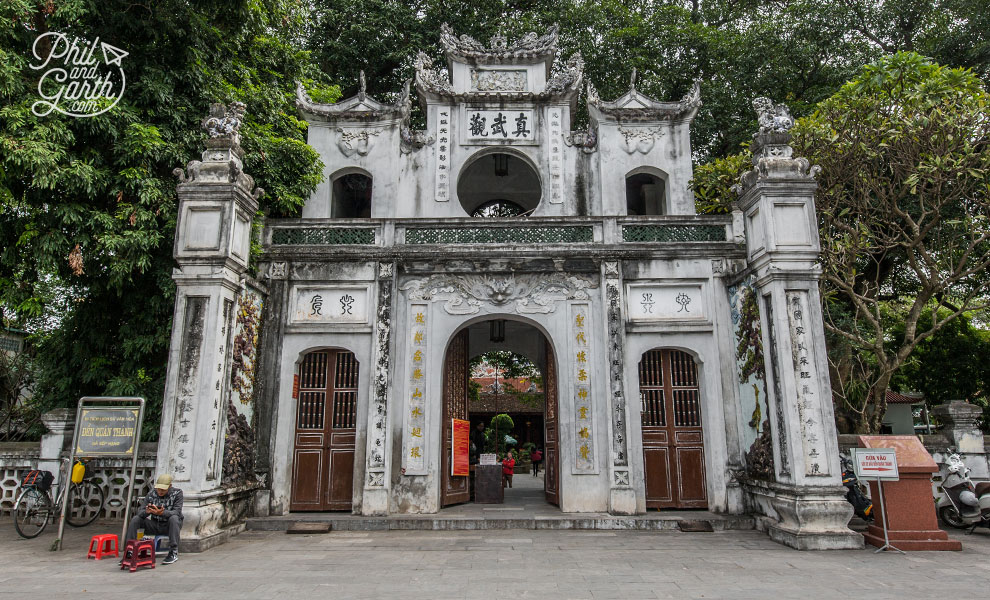
The impressive entrance of Quan Thanh Temple
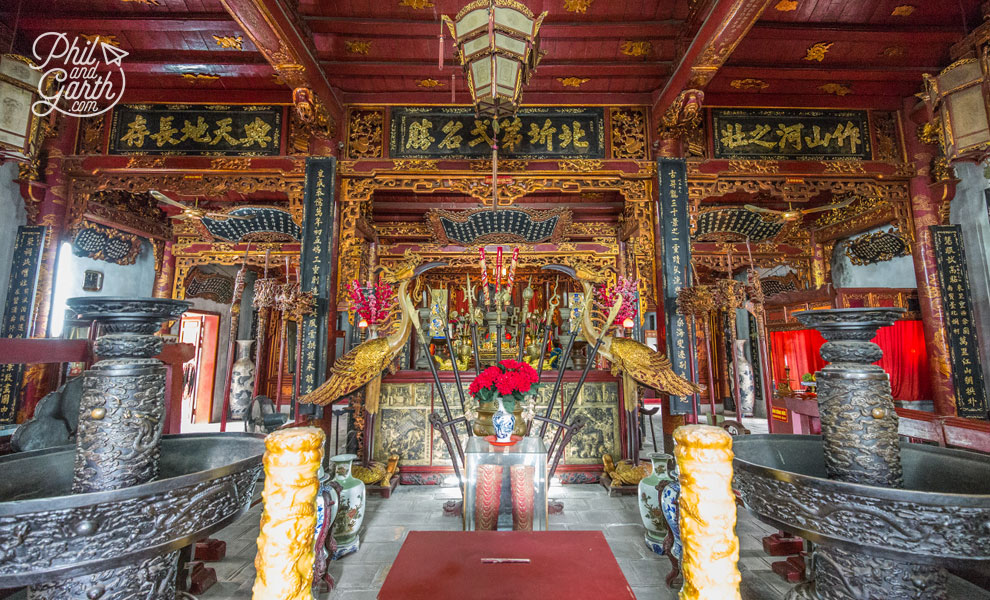
Inside the Quan Thanh Temple
Statues of cranes stand on the backs of turtles, you’ll see this in temples across Vietnam. When together they symbolise power and longevity. Inside there’s a huge black bronze statue of Tran Vu, who is one of the highest ranking Taoist deities. Incredibly the statue is over 1,000 years old.
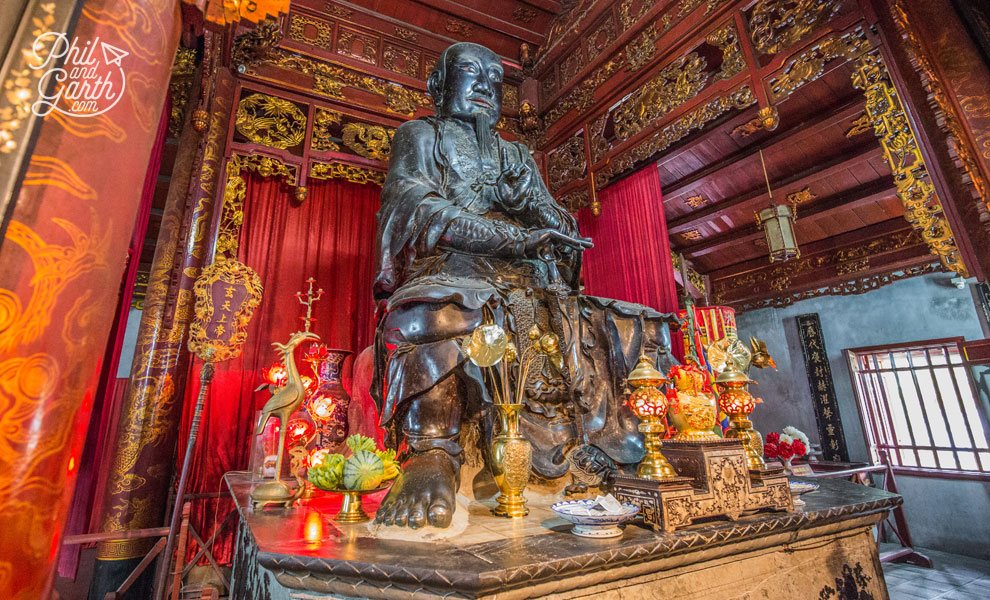
Tran Vu 1,000 year old statue
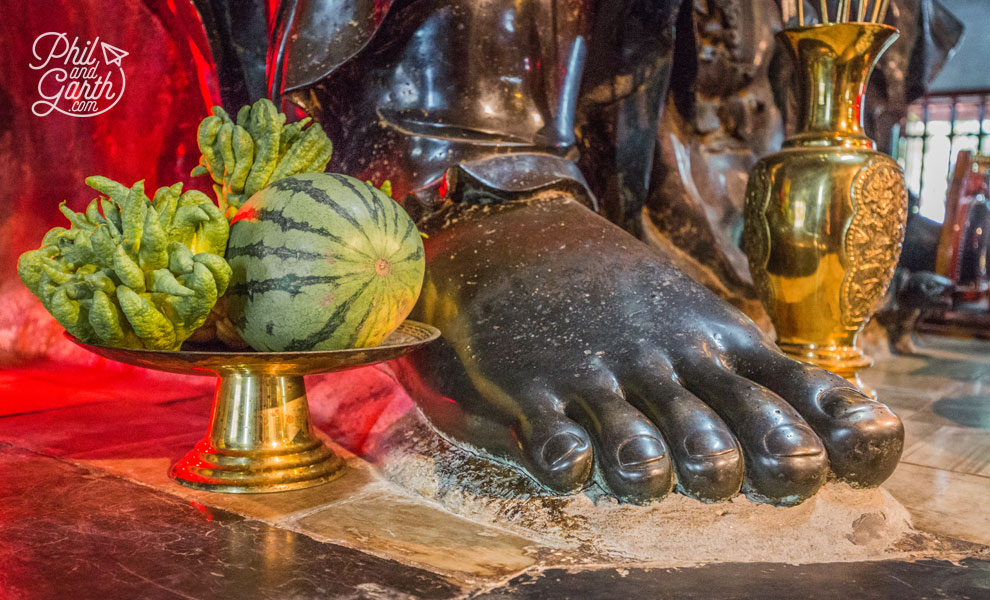
Bananas and melon give you a sense of the scale
Phil like many other people rubbed his toe for good luck.
French Quarter cyclo ride
We took a cycle tour around Hanoi’s faded colonialism. We were right in thick of the road chaos, exhaust fumes and dodging motorbikes. Having done this we’d suggest you do this first to get a sense of Hanoi’s scale.
Once you get into the French Quarter the streets are much wider, just like the boulevards you would find in Paris. We passed the Neo-Gothic Saint Joseph Cathedral and Hanoi’s Opera House plus expensive looking hotels and grand government buildings in this leafy neighbourhood.
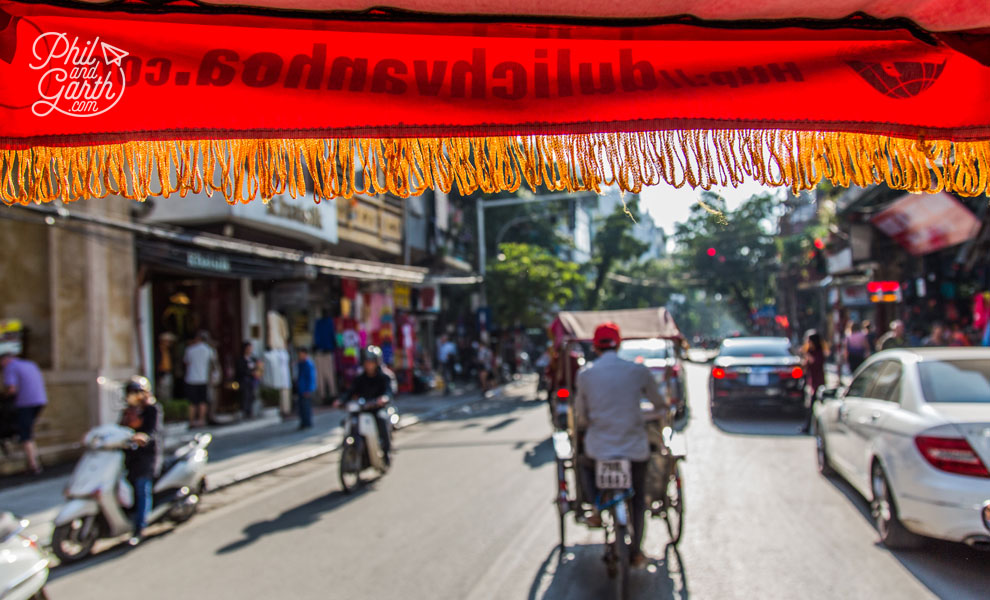
Cyclo rides offer unique views in the thick of the traffic
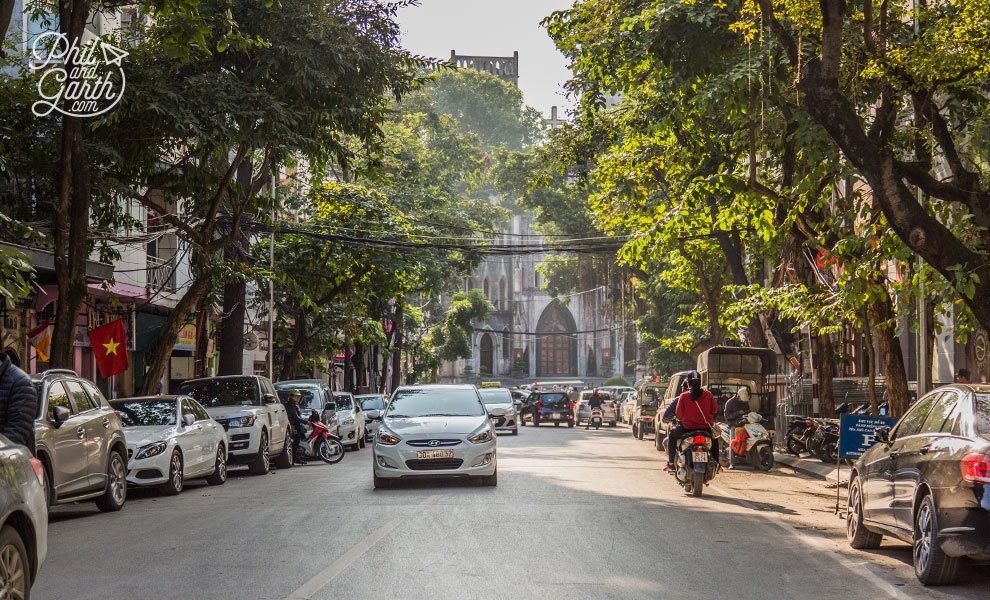
French Quarter and Saint Joseph Cathedral
Vietnamese Water Puppet Theatre
A must see is Vietnam’s folk art of water puppetry. It originated in the flooded rice fields of the Mekong Delta in the North of the country and has been passed down the generations. Phil loves theatre, and was fascinated by how they used long rods to make the puppets appear like they were dancing on the water. They also used fireworks that seemed to be set off under the water then rose above the surface – so how does that work? One lady sitting next to Phil asked “Are the puppeteers sitting under the water?” – Not unless they can hold their breath for half an hour he replied! I don’t think she was impressed!
We went to the Lotus Water Puppet theatre next to the Hoan Kiem Lake. It lasts 50 minutes with 12 short traditional water puppet acts.
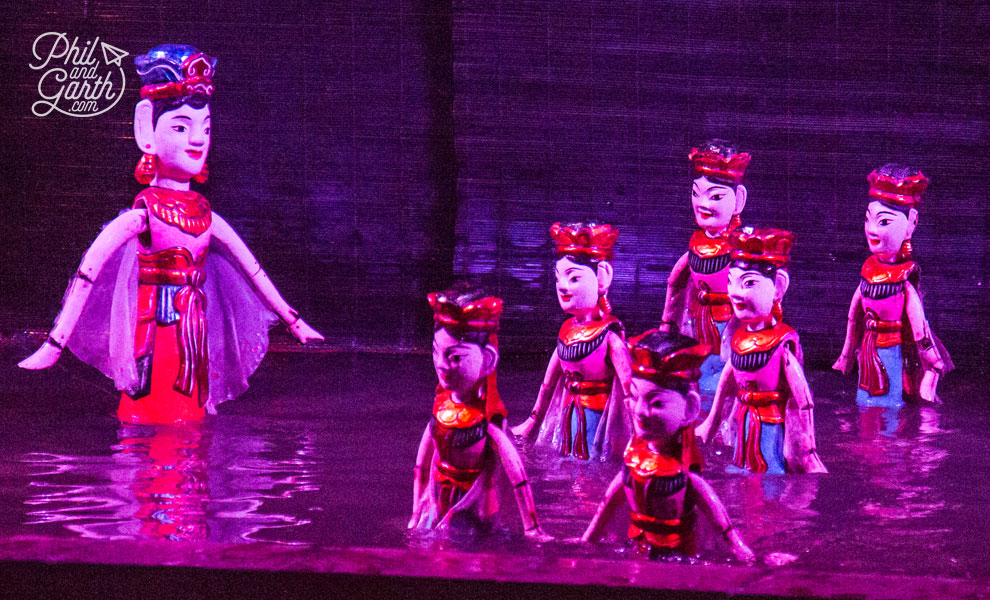
Vietnamese Water Puppet Theatre
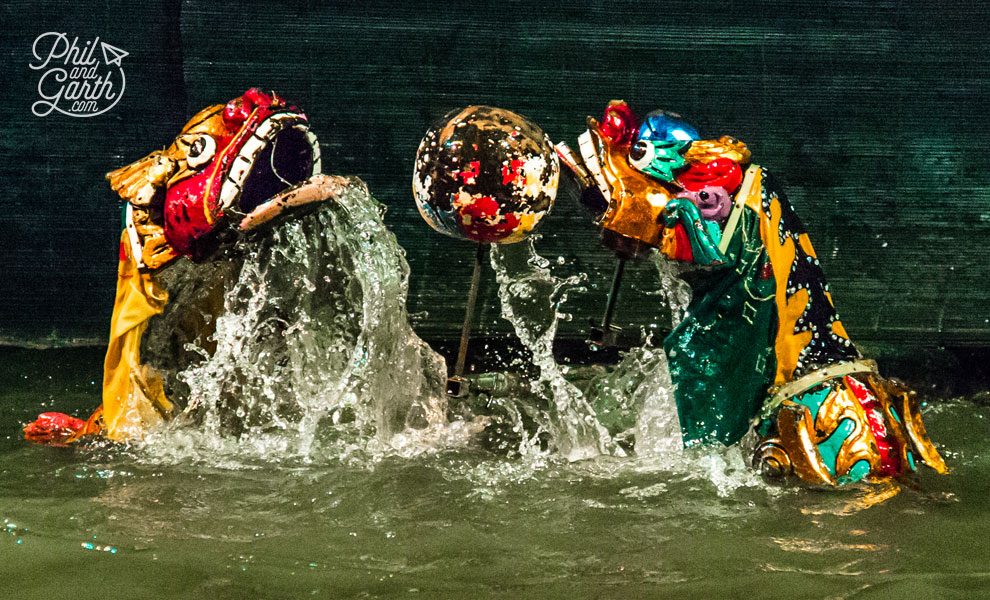
The stage is a pool of water
Đồng Xuân Food Market
We generally can’t do an Asian city without a visit to the local market, so we went to Đồng Xuân Market, a wholesale market. Busy scenes inside with people trading bags of shoes and silks, but far more interesting were the food markets on the other side, there’s no tourists here, just people going about their business. Here’s a quick photo essay of what we saw..
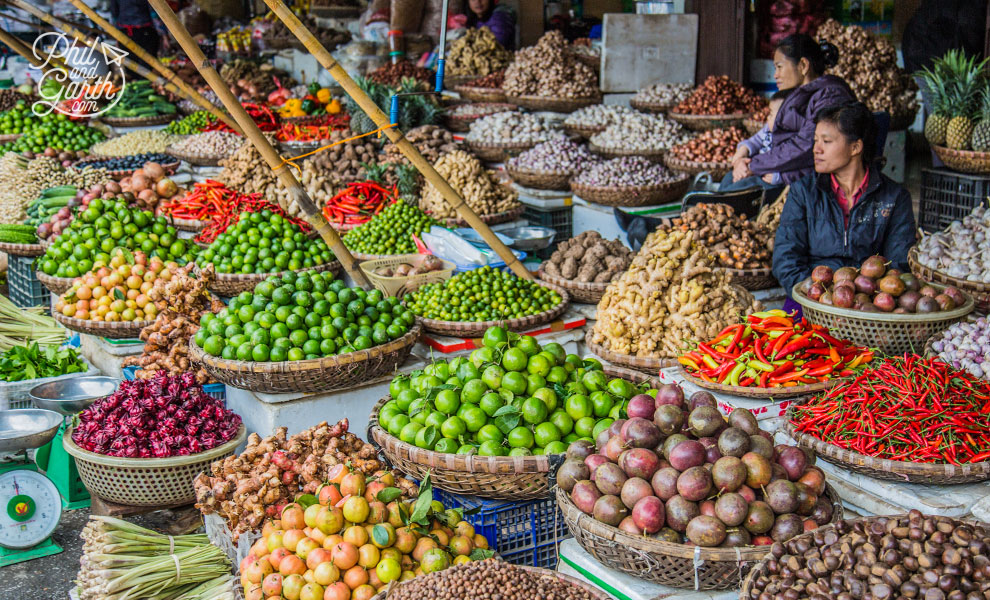
Colourful scenes of limes, chillies, ginger and shallots
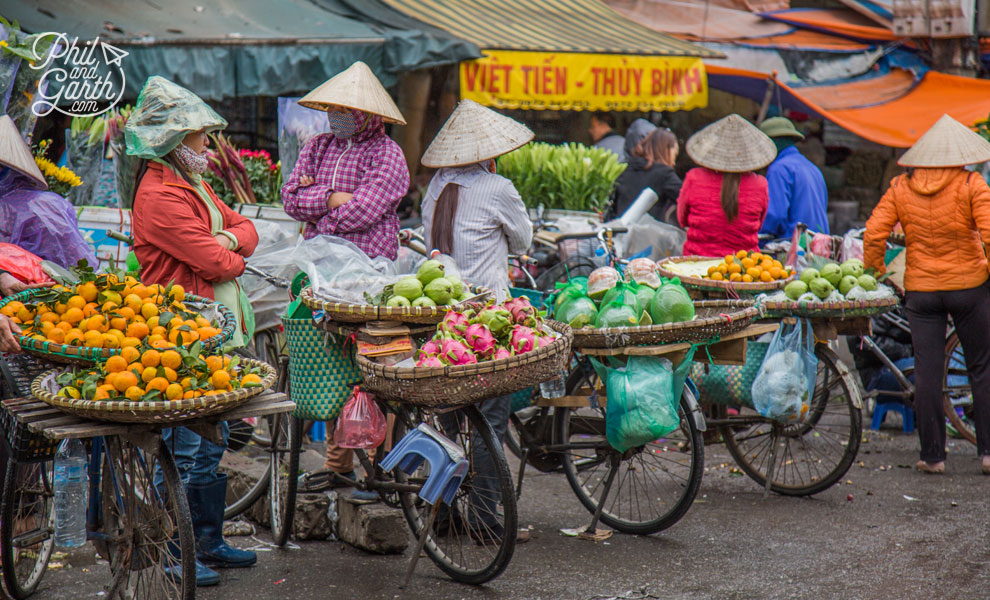
Fruit vendors in their iconic conical hats
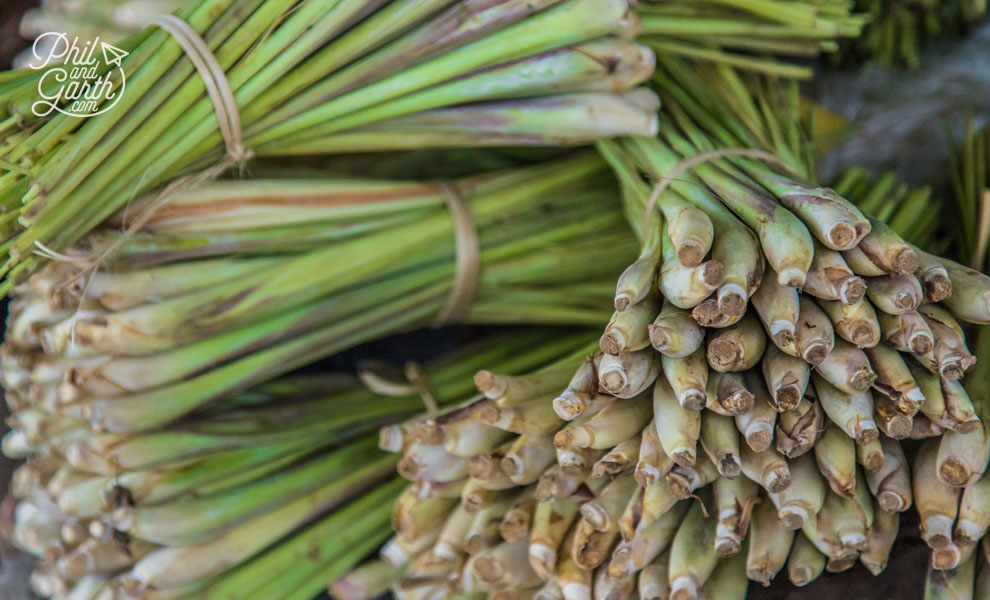
Fresh lemongrass for sale
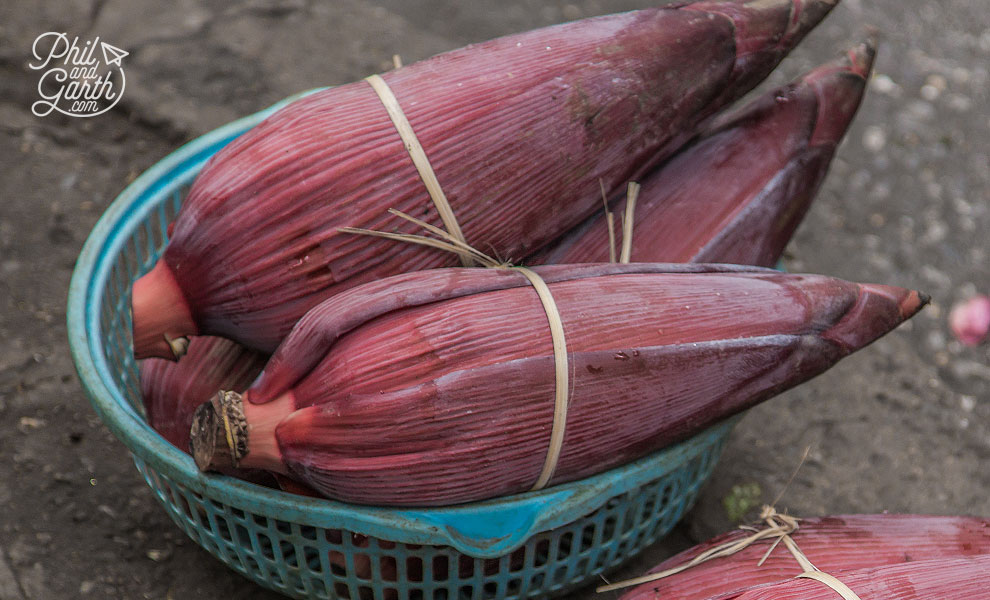
Banana flowers, the insides are used in salads
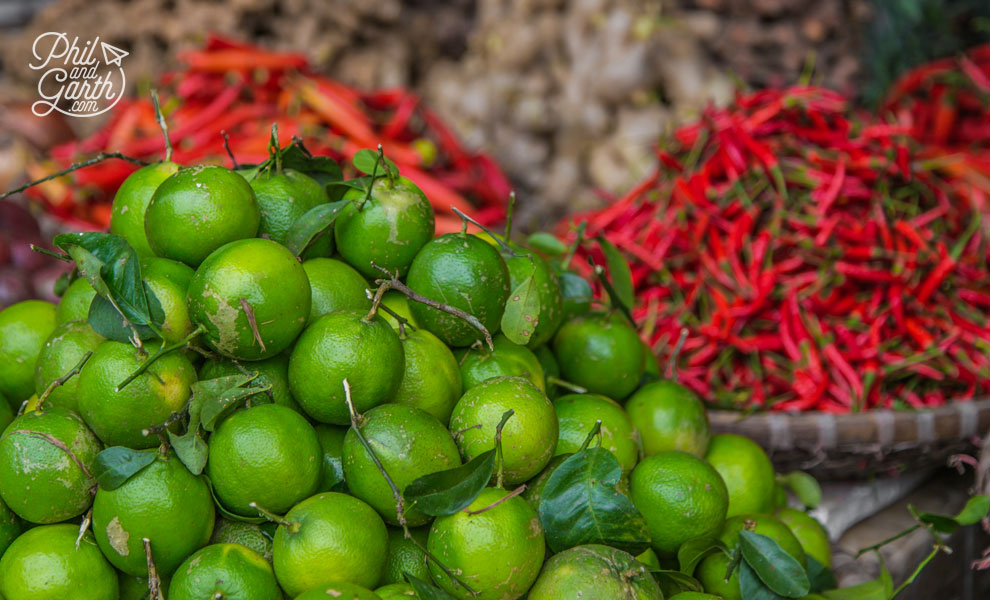
Colourful limes and chillies on sale
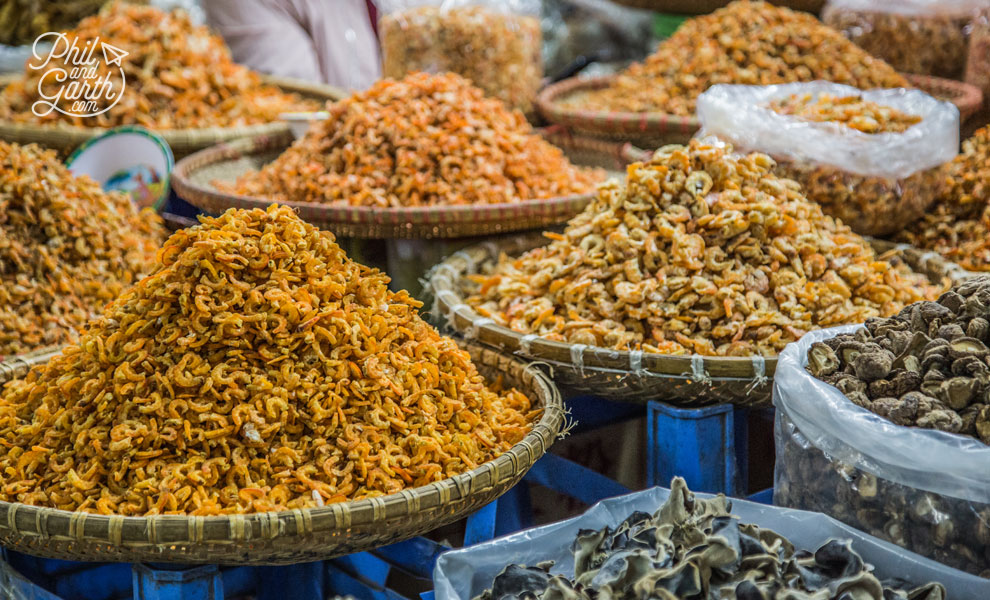
Baskets of dried shrimp, the staple ingredient in many Vietnamese dishes
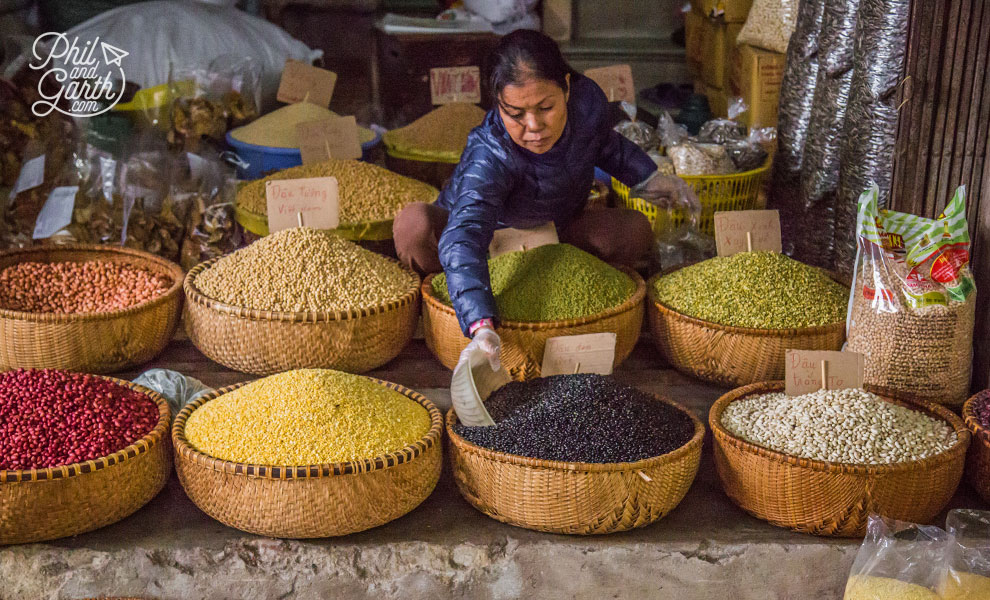
This lady had baskets of beans and different varieties of rice
Hanoi Street Food Tour
To familiarise ourselves with Hanoi’s food culture we took a walking food tour around the Old Quarter. We had done one in Prague and found it was a brilliant way to discover the culinary delights of the city. There’s a few food tours to choose from, we chose Viet Mind Tours and paid just $25 each for 3+ hours, which was incredible value for money considering how much we ate. Our guide was the owner, Mr Ha Nguyen. Ha was brilliant, so knowledgeable and spoke great English. He answered all our questions, and was genuinely interested in us too, Ha even tailored the tour for Garth, knowing he was into photography, and took us to interesting alleys and other parts of the Old Town along the way. Ha also runs photography tours which must be fascinating with insider knowledge.
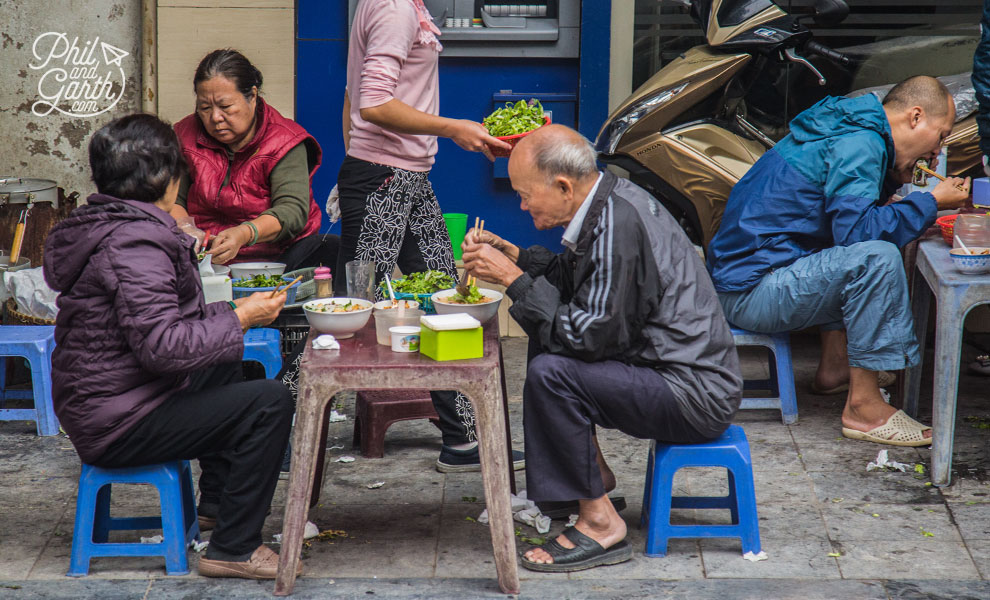
People enjoying street food in the Old Quarter
Banh Cuon
First up was Banh Cuon, a steamed rolled rice pancake. Ha took us to Bánh Cuốn Gia Truyền Thanh Vân, a restaurant that serves the best Banh Cuon in Hanoi. Eaten hot or cold, it’s best hot. Ha then showed us an ingredient in an ice-cream tin – ground up cockroaches! – use to make things spicier, um no thank you.
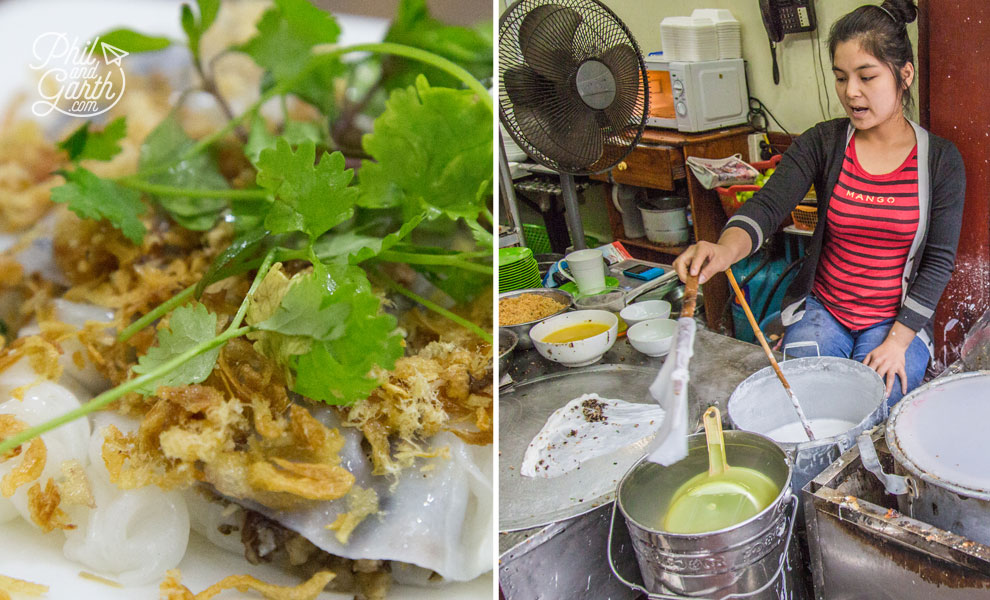
The best Banh Cuon in Hanoi
Street Tea
Next it was time to sit with our knees under our chins on the little blue nursery school chairs you see everywhere. On the streets are loads of tea vendors, we tried some hot tea, which of course Garth hated, and Phil loved.
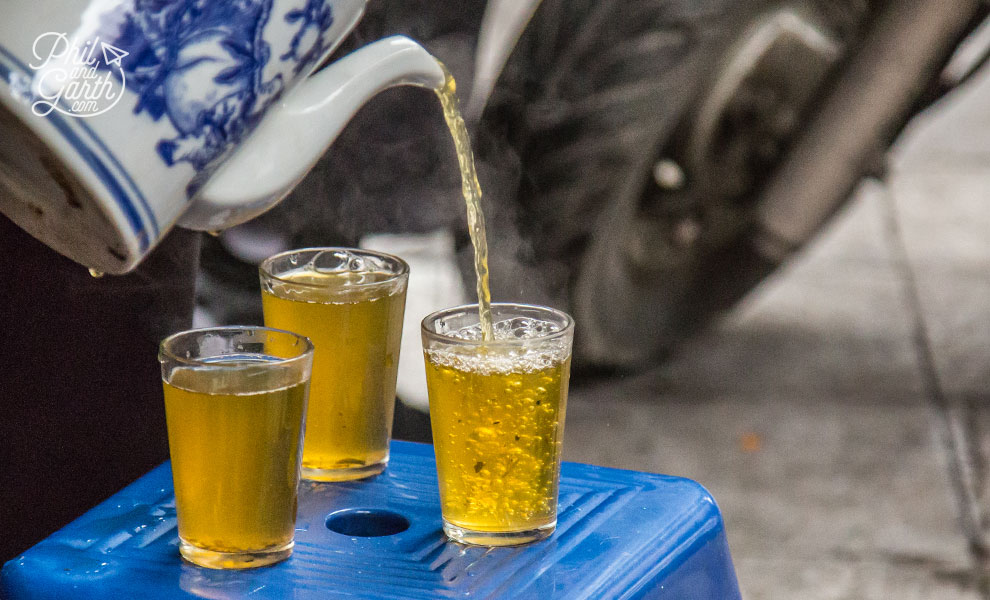
Hot Vietnamese tea on the street
Banh Mi
Ha then took us to try Banh Mi, the Vietnamese bread sandwich, one of the obvious foods passed down from the French colonial period – It’s a baguette served with various fillings like pate, vegetables or cheese.
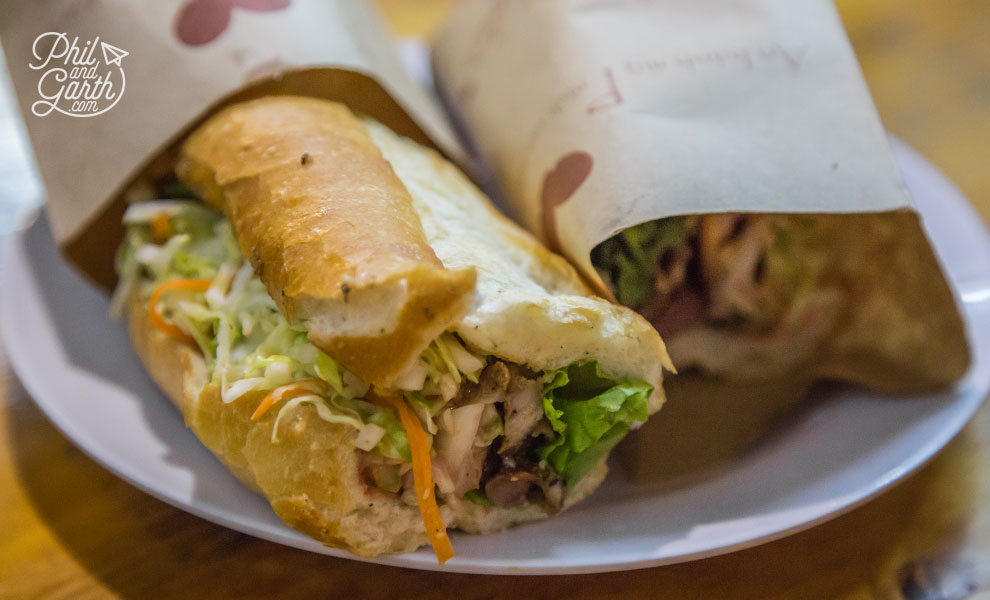
Banh Mi Vietnamese bread
Banh Xeo
Next was the fried rice pancake dish – Banh Xeo. It was crispy and delicious! We also tried Ha’s dish – Dau Pho Sot Ca Chua – fried tofu in a tomato sauce.
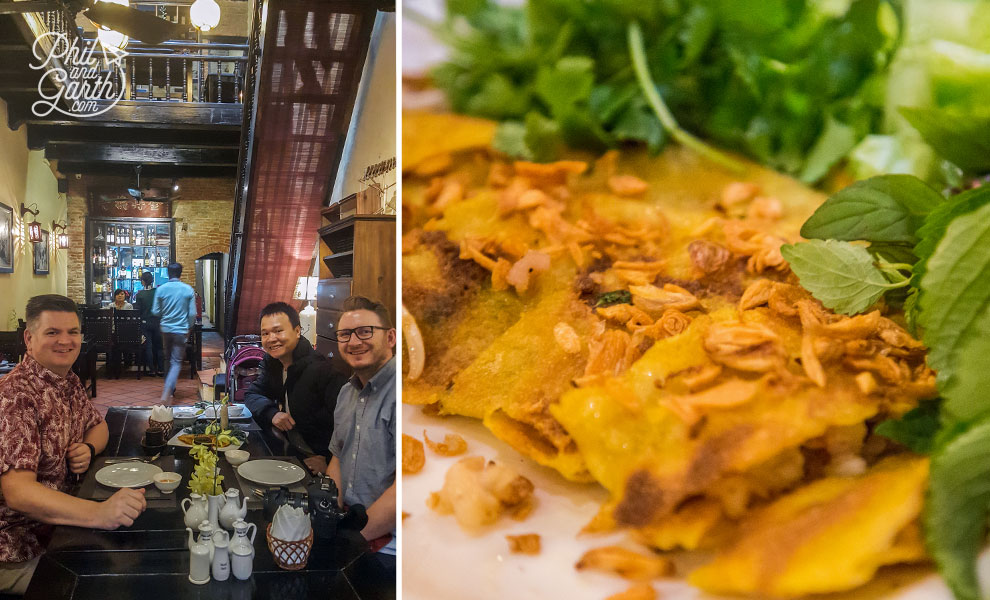
Banh Xeo fried rice pancake
Egg Coffee
Egg coffee! ok it sounds disgusting but it was actually quite nice, well Garth thought so. Roasted coffee, with a topping made from condensed milk and egg yolk whisked up till its frothy. The unique recipe was created by a bartender accidentally when there was a milk shortage. Today his children run the two most famous cafes – Cafe Giảng and Cafe Đinh.
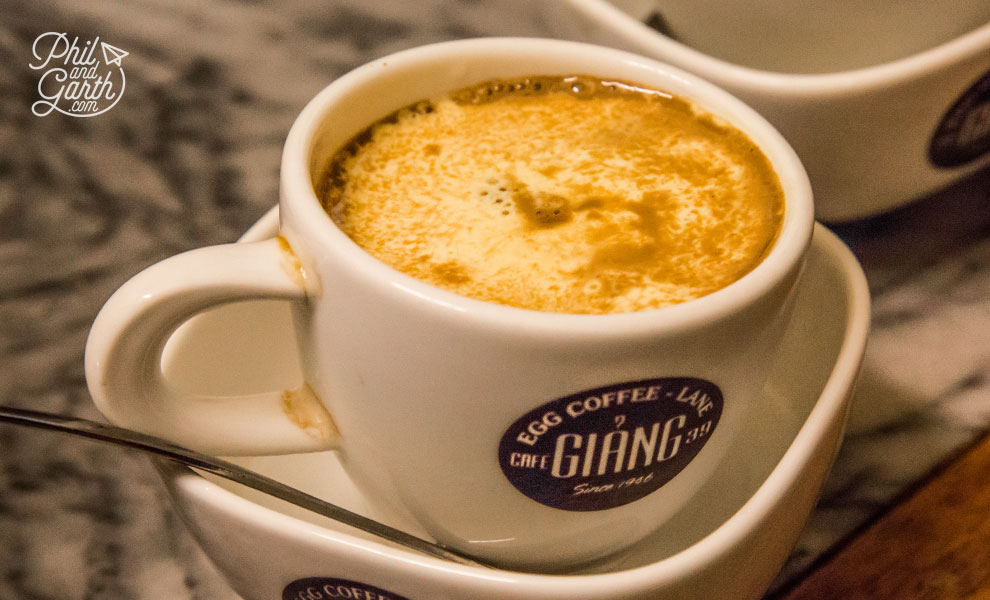
Unique tasting Egg Coffee at Cafe Giang
Bun Cha
Left in the picture is Pho Ga Tron, a dry chicken noodle dish, but tastier and something we subsequently ate lot of was Bun Cha, rice vermicelli noodles with grilled pork in a light fish sauce. Bun Cha is also Hanoi’s signature lunch dish.
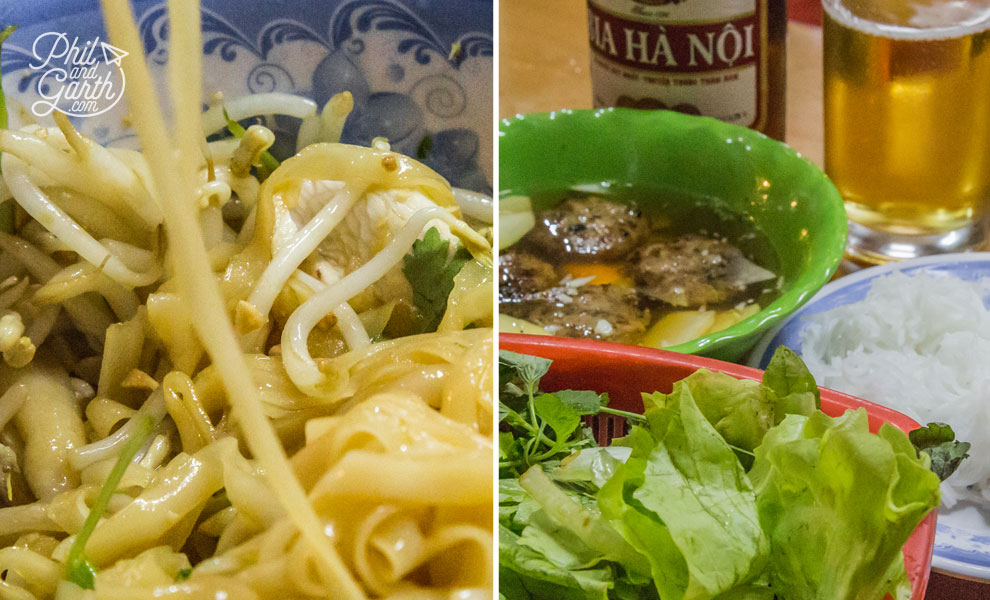
Pho Ga Tron and Bun Cha
Pho
Time for Pho, Vietnam’s most popular dish. It originated in Hanoi, and is probably the most famous dish exported to the West. Flat rice noodles with beef or chicken, lots of fresh herbs and a broth. The Vietnamese slurp this at anytime including for breakfast, Phil loved it for his breakfast too. Pho is said to have originated from Chinese refugees who settled in Hanoi. Chilies, garlic and lime wedges are served on the side.
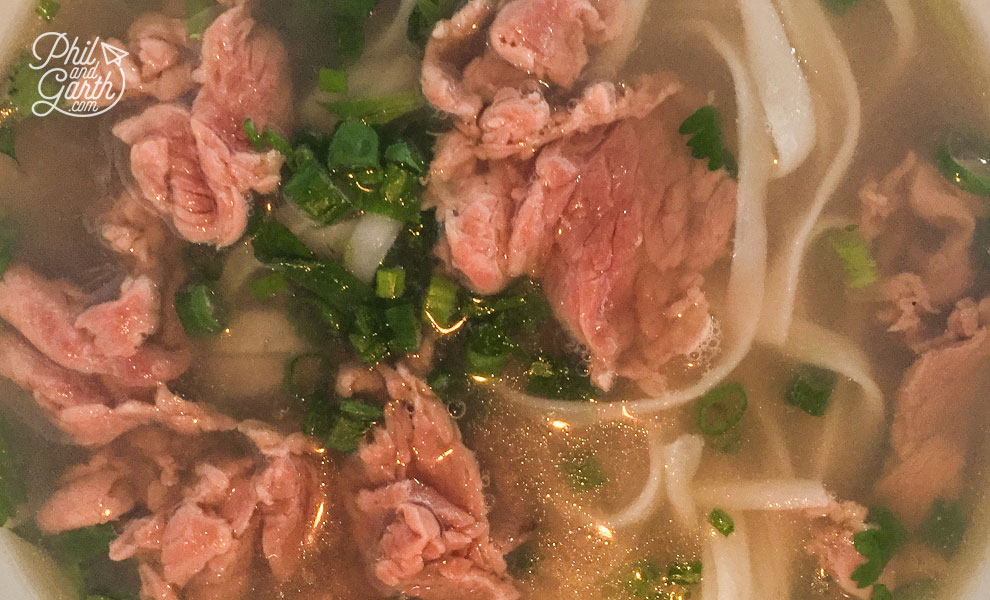
The most popular dish – Pho
Nem Ran
By now we we’re really full up, our last dish was Nem Ran, delicious fried spring rolls of ground meat, mushroom and veg. But that was it! we were beaten by the food, no more. Ha was so apologetic as he wanted us to taste more food, but we just couldn’t do it, Phil was delighted that we’d tasted more than we thought we would.
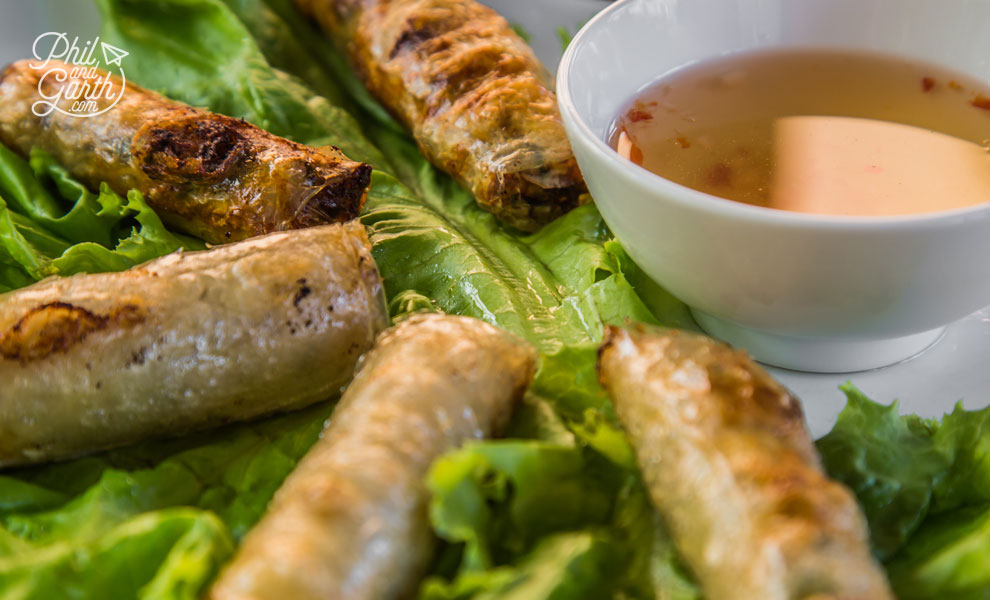
Nem Ran fried spring rolls
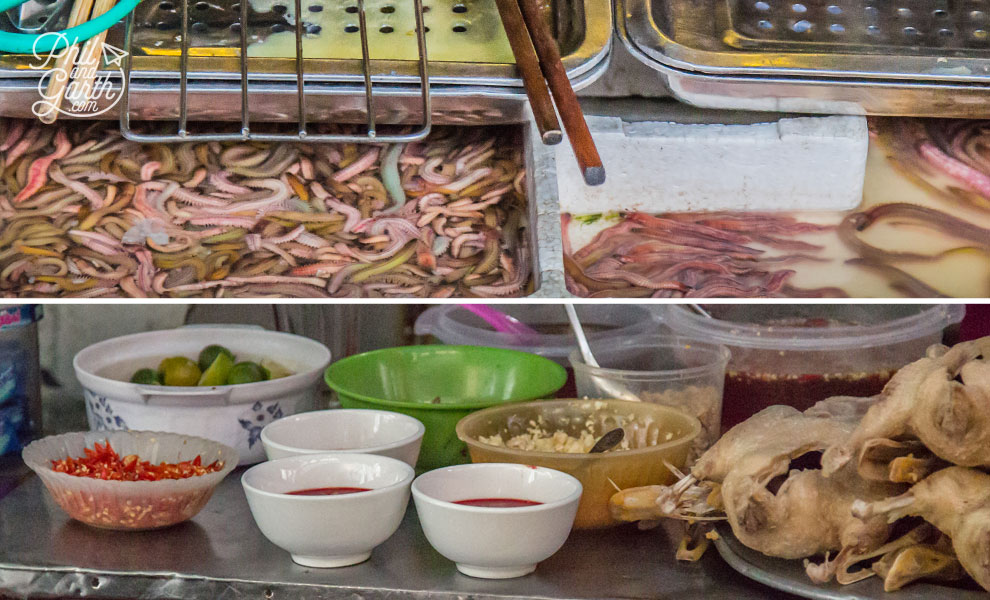
Alien looking foods for sale
As well as tasting, we saw some less appetising foods that backpackers and more adventurous travellers love to try. How about Sea Worms or Ducks Blood? Fried Pigs Intestine or even Snake? Ha said most westerners get upset stomachs eating these, we weren’t surprised!
Overall we thought street food was great, for a few reasons:-
- It’s really cheap, perfect if you’re on a budget.
- It’s nowhere near as spicy hot as Thai food.
- Vietnamese food is so healthy no wheat, no dairy, high in protein and we loved the tons of fresh herbs in the dishes.
A couple of other eateries we liked were – Cafe Nola, a quiet and quirky place to eat. Chả Cá Lã Vọng, a 100 year old restaurant that serves one dish cha ca La Vong – River fish (a bit like cat fish) cooked in turmeric, dill, chillies, coriander and spring onion. It was featured on the BBC’s Rick Stein Far Eastern Odyssey.
The World’s Largest Ceramic Mosaic
Finally as we left Hanoi for our next stop Ha Long Bay, we passed the world’s largest ceramic mosaic, 5 miles – who knew?!
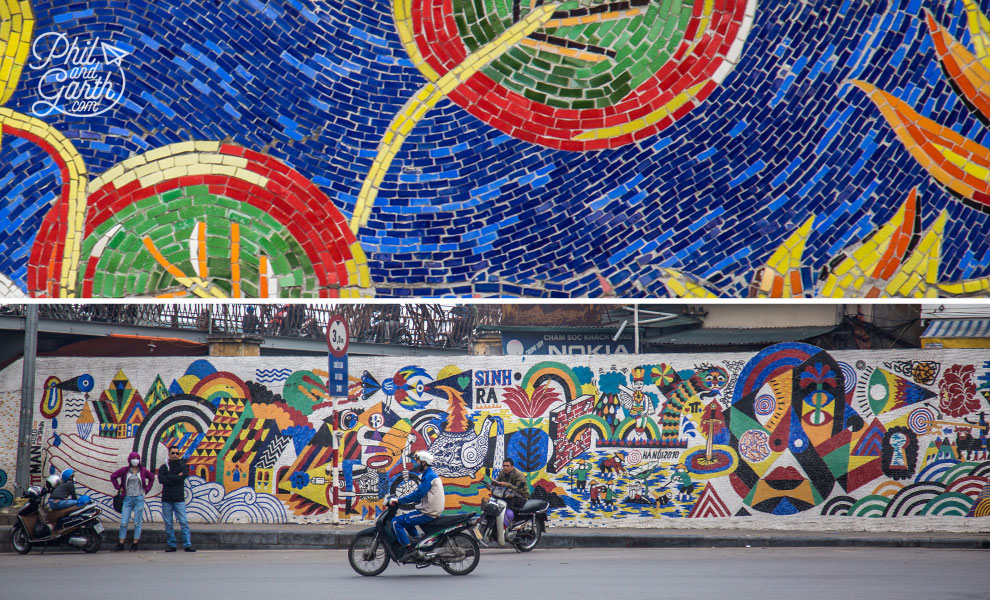
Hanoi has the world’s largest ceramic mosaic
Hanoi Practical Information & Useful Advice
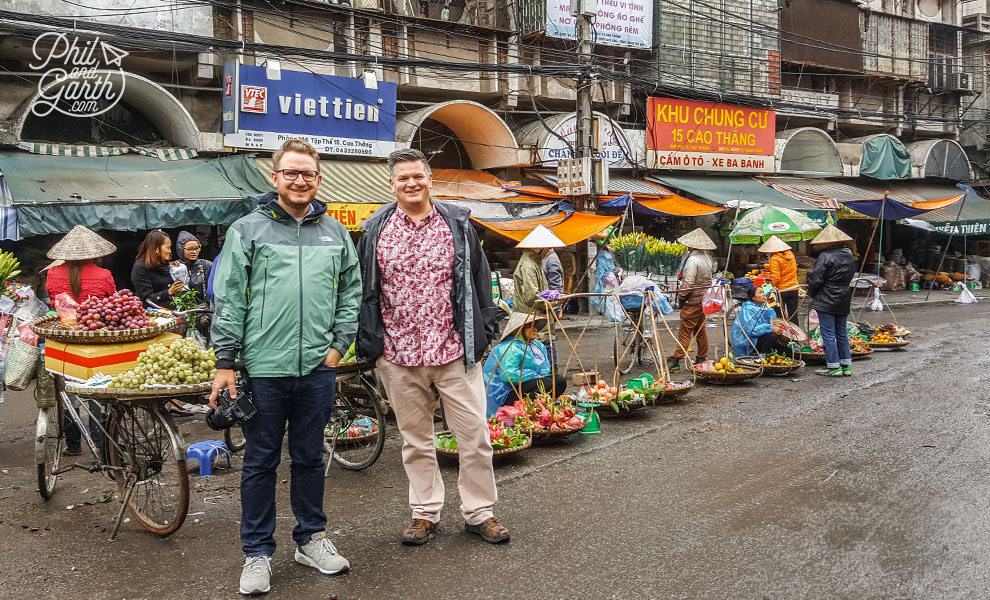
Garth and Phil in Hanoi
Phil and Garth’s Top 5 Hanoi Travel Tips
- Tip #1: The best time to visit is Nov – March it’s dry, has the lowest humidity, but the nights can be cold.
- Tip #2: Hardly anyone speaks English, so grab your hotel’s business card if you are hiring a taxi or cyclo.
- Tip #3: For safe eating – avoid water. Don’t eat any salads and take out ice in drinks, we also brushed our teeth with bottled water.
- Tip #4: Carry hand sanitiser and toilet wipes with you at all times. You’ll be glad you did.
- Tip #5: Got more time? Take a day trip to the amazing landscape of Tam Coc – described as ‘Ha Long Bay on land’
How We Did It
- We paid for a small group guided tour of Vietnam (Vietnam & Cambodia Uncovered) with Inside Asia Tours
- Our Hanoi food tour was with Viet Mind Tours organised through our hotel La Siesta.
- We visited Hanoi in mid November.

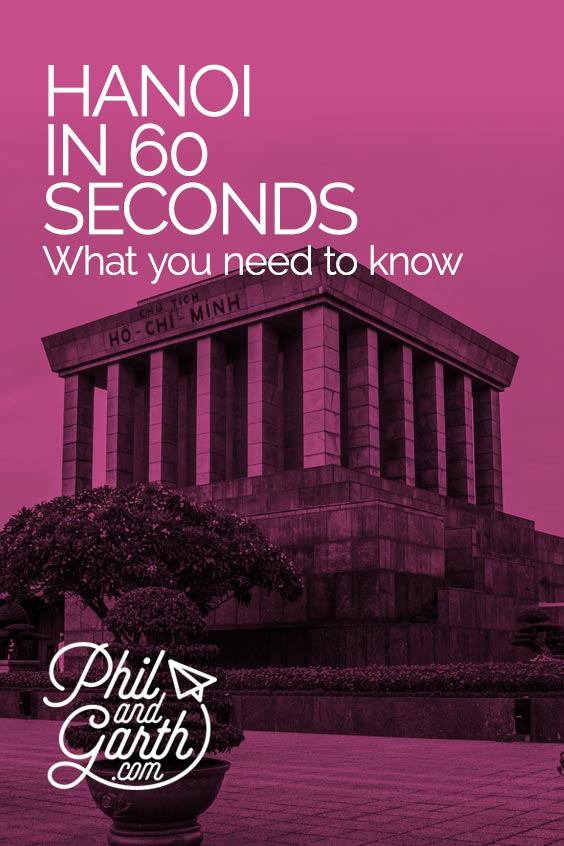
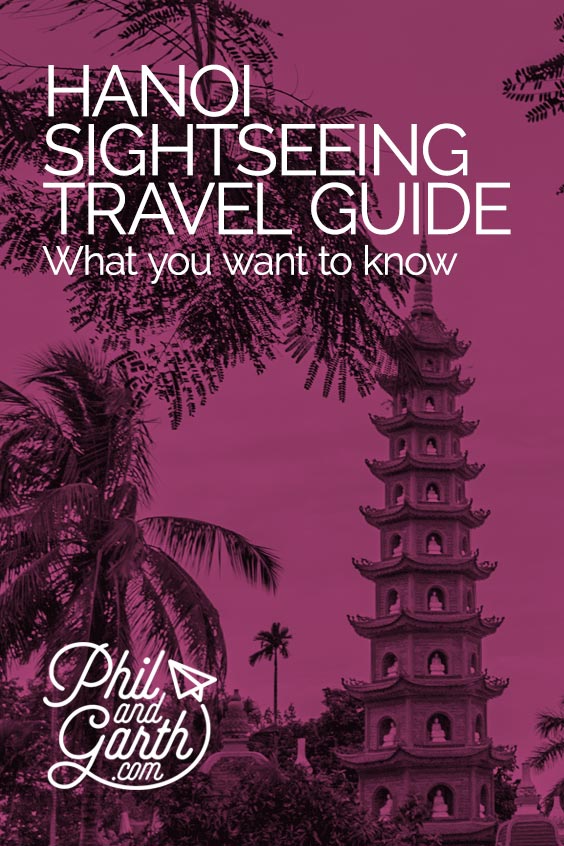

34 comments
I just booked a plane ticket to Hanoi! This post got me so excited to try all of the street food and wander around in the streets.
Thank you so much for sharing. I got some great information on what not to miss during my travels. 🙂
xxx
Lotje
So great to look through your photos and reminisce about my trip to Hanoi. It was probably my favourite city in Vietnam for all the reasons you’ve shown here. I went to the Highland coffee above the Legend’s beer for the same view, such a great spot to watch the traffic. I found a nice cafe/restaurant on the corner of a 5-way intersection and just whiled away the afternoon watching the city go by. Fantastic photos as always and they really bring back great memories. Glad you had fun.
Wow! Those pictures are amazing! I used to live in Thailand and I’m married to a Thai national. Next time we’re in Thailand we plan on going to Vietnam. Truly amazing pics, honestly – I’m impressed! Nice post.
Loved seeing the hustle bustle of the city. Hanoi looks absolutely stunning city.
The architecture , market , graffeti on wall , culture and views everything looks so astonishing.
Adding Hanoi to my bucket list. You have captured all the pictures very beautifully!
You guys are killin’ me! 😉 Your pictures are awesome – as always! (Except now I really want banh mi…should have eaten before reading!) This is one of those posts you don’t just read, but savor. So good! We are so bummed that our plan to visit Vietnam this year is being put off…but next year, for sure! Thanks for taking is with, guys!
Fantastic post! As always your photos are stunning! Thank you for sharing. 🙂
Wow, you guys certainly did a lot in Hanoi! The traffic looks absolutely crazy. I am going to Nepal in April and heard it’s going to be the same! The food tour sounded incredible minus the sea worms and grounded cockroaches! Yuck! Haha! I can’t believe some of the stuff they eat in South East Asia. I would love to go exploring the markets and that train track is very unusual ha! Thanks for sharing your story with us! Gives us something to dream about! I am saving this for my travels in Vietnam!
I love this post! I love Banh Mi and Pho! Guess I have to go to visit Vietnam to try the authentic stuff. Until then I’ll keep asking my Vietnamese friends to share some of their cooking with me. Great and informative post! Pinned for later.